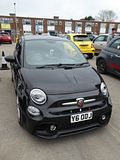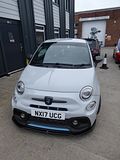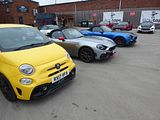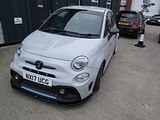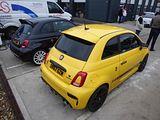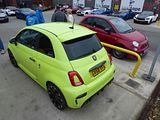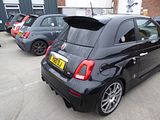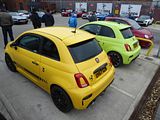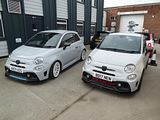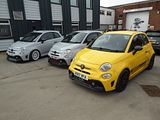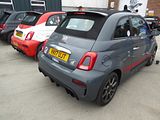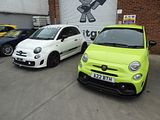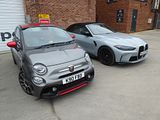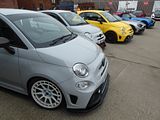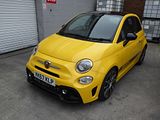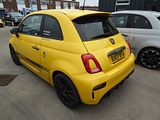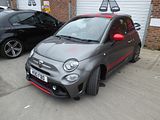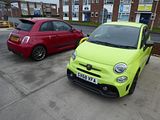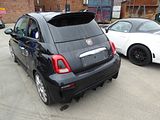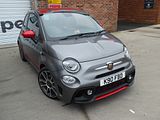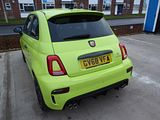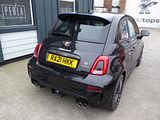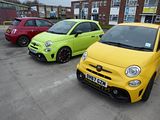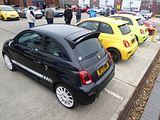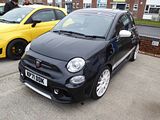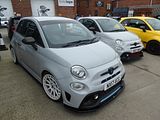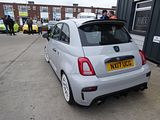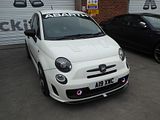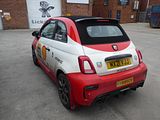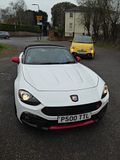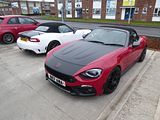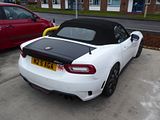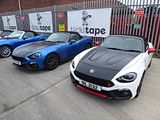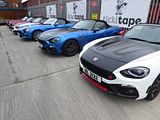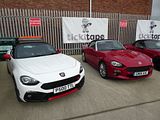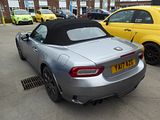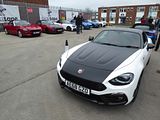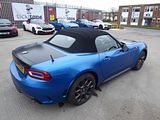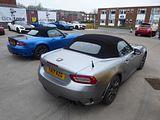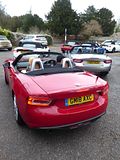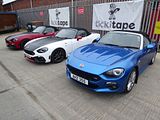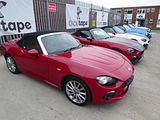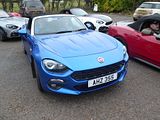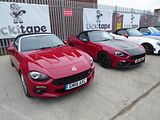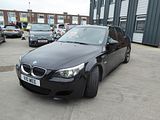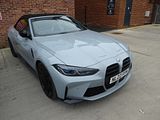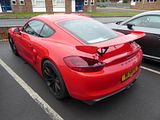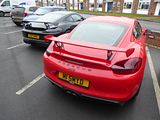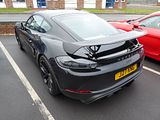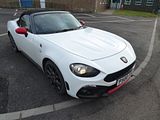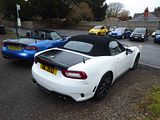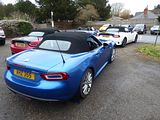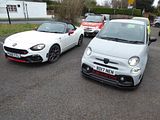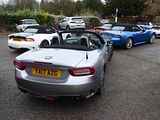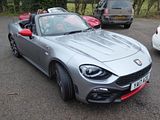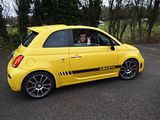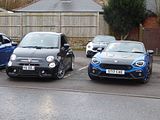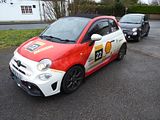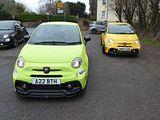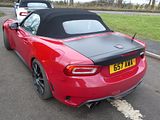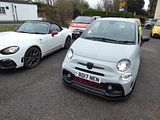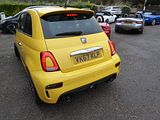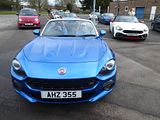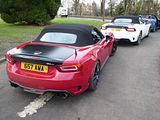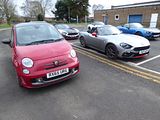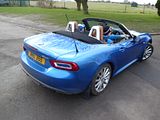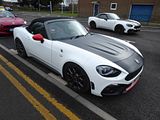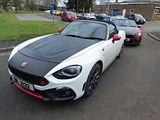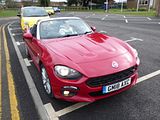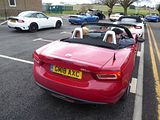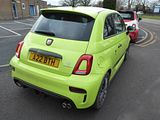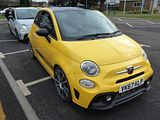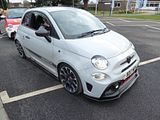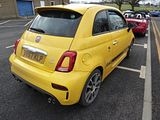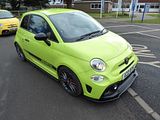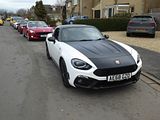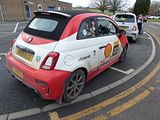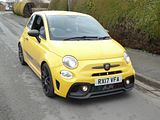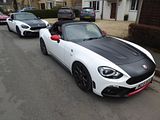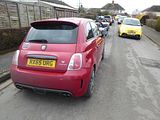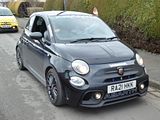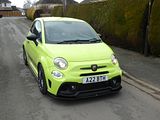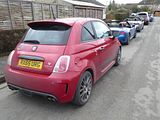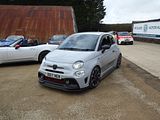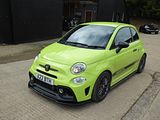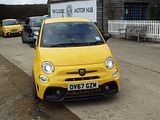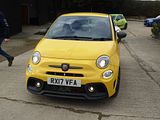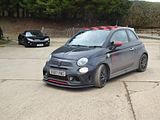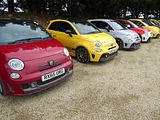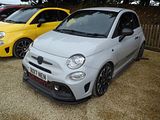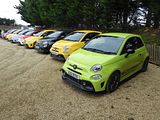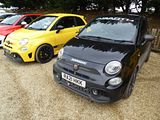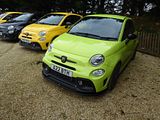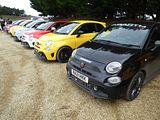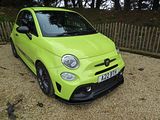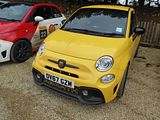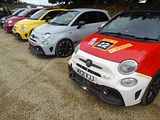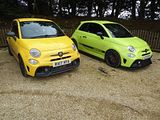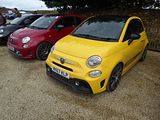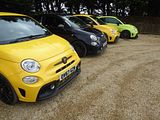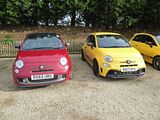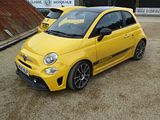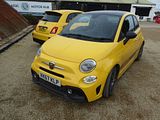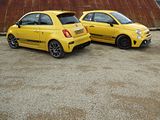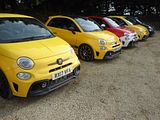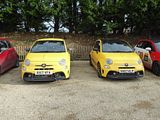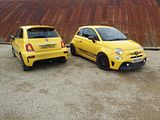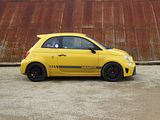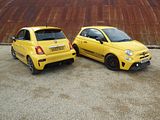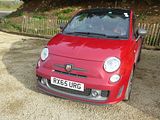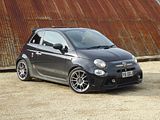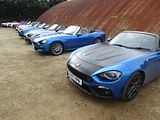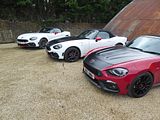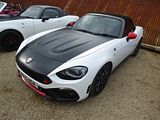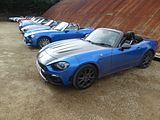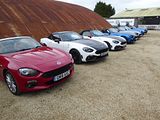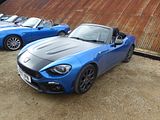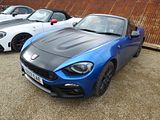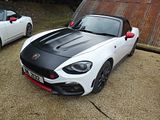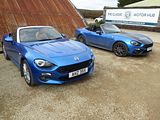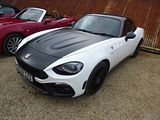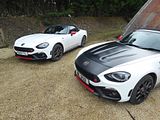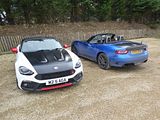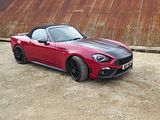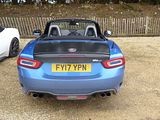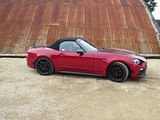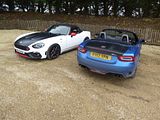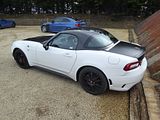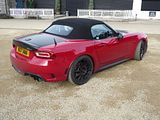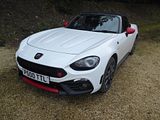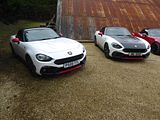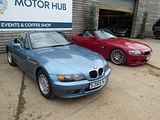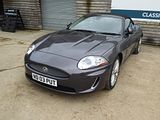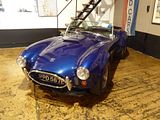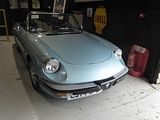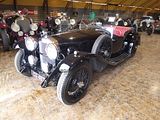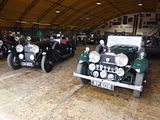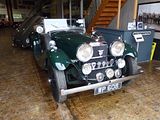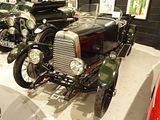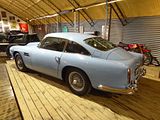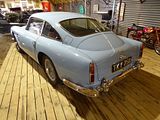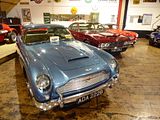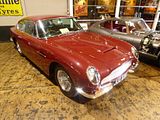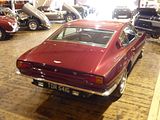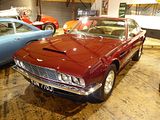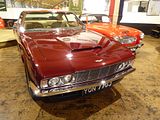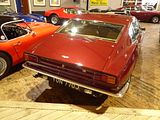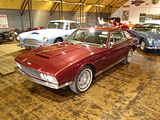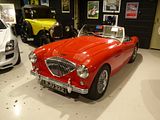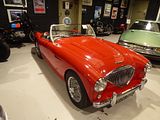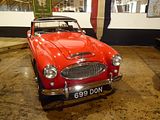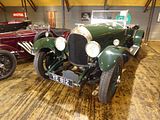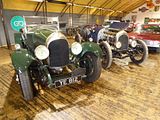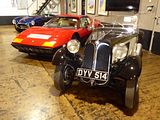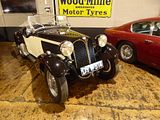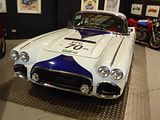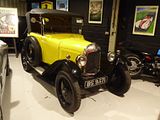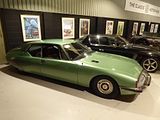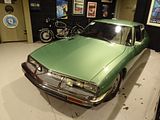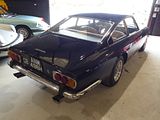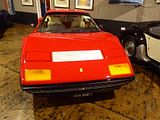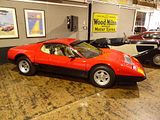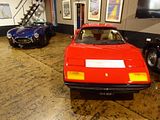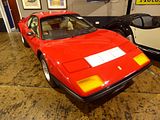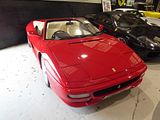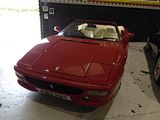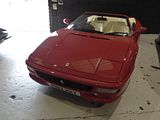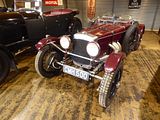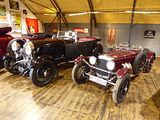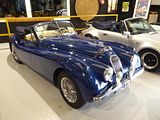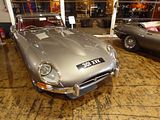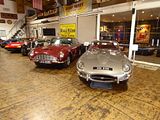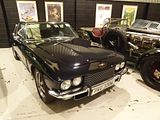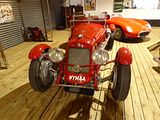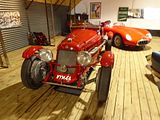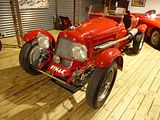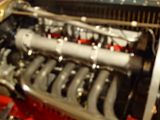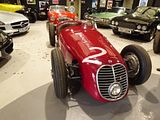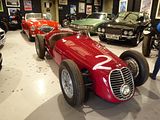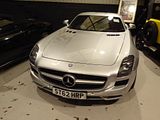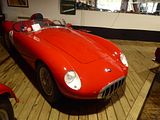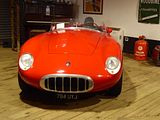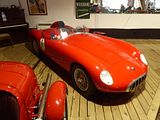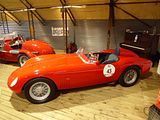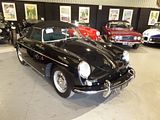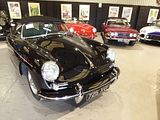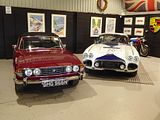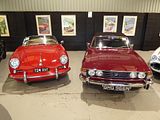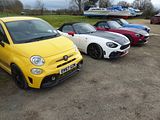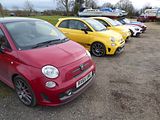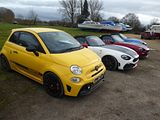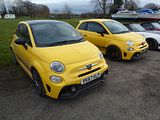Following the success of an event in September 2022 which started out at the increasingly popular Podium Place in the centre of Newbury and which then, after a fortifying coffee and bacon roll, saw the group heading across the Cotswolds to the Classic Motor Hub, it was only a matter of time before the route was dusted off and a repeat would be organised. That September 2022 event was initially conceived for the Fiat and Abarth 124 Spider community, though others were welcome to join, which saw me going along in the Maserati and a couple of other Abarths joining in the fun and such were the favourable reports from everyone that it was decided that this would be promoted as an Abarth Berkshire event as well as a 124 Spiders activity. Despite the fact that this was February, the weather gods were kind, giving us a dry day (as indeed most of the month has been), and it was far warmer than can often be the case this early into a new year, so most of the Spider owners were able to enjoy open-topped motoring. Let the text and the pictures present the day and the cars that so captivated us all.
AT PODIUM PLACE
Assembly point was at Podium Place which is a now quite a well known venue for the car and bike enthusiast. It is located in the centre-ish of Newbury, though down a road you would probably never use unless you were lost or knew of the existence of this venue, but now it has been in operation for a couple of years, plenty of people do indeed manage to find it. It is the “home” of Abarth Berkshire and the staff there always welcome any Abarth with particular enthusiasm, and they also serve excellent coffee and bacon rolls, so it was an obvious choice for the start of the day and to allow people who had travelled a bit to fortify themselves for what lay ahead, as well as the inevitable photo taking, and catch up with friends who had not seen each other for a little while, as well as the introduction to a number of people for whom this was their first event. Not surprisingly, it took quite a determined effort by event organiser to get everyone into their cars when the time came to leave.
ABARTH
The majority of the Abarths here, this time, were 500-based models.
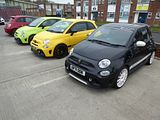


 Among the oldest here, slightly surprisingly, was mine. Rumours started to circulate towards the end of 2014 that Abarth were going to upgrade the Competizione model, so as better to bridge the gap between the Turismo and the 190 bhp 695 Biposto that had been added to the range earlier in the year. It was Geneva 2015 when the result was finally shown to an expectant fan base. Most exciting news was that thanks to a bigger Garrett Turbo, the engine had been tweaked to 180 bhp, and with reduced CO2 emissions. A standard spec that included Koni Dampers, Brembo brakes, Xenon lights, Sabelt seats, Climate Control, parking sensors as well as other refinements that had been added like the TFT instrument display all proved very compelling, so not long after the first cars reached the UK in June of 2015, I found temptation too hard to resist, and as is well documented here, swapped my 2010 car for one of these. At the time I ordered it, Cordolo Red, a tri-coat pearlescent paint which shimmers in bright sunlight looked set to become one of the most popular colours of the lot, even though it is a cost option. Indeed, the Launch Edition models were all offered either in this colour or Scorpion Black, with black wheels. Surprisingly, the colour was not carried over to the Series 4 cars.
Among the oldest here, slightly surprisingly, was mine. Rumours started to circulate towards the end of 2014 that Abarth were going to upgrade the Competizione model, so as better to bridge the gap between the Turismo and the 190 bhp 695 Biposto that had been added to the range earlier in the year. It was Geneva 2015 when the result was finally shown to an expectant fan base. Most exciting news was that thanks to a bigger Garrett Turbo, the engine had been tweaked to 180 bhp, and with reduced CO2 emissions. A standard spec that included Koni Dampers, Brembo brakes, Xenon lights, Sabelt seats, Climate Control, parking sensors as well as other refinements that had been added like the TFT instrument display all proved very compelling, so not long after the first cars reached the UK in June of 2015, I found temptation too hard to resist, and as is well documented here, swapped my 2010 car for one of these. At the time I ordered it, Cordolo Red, a tri-coat pearlescent paint which shimmers in bright sunlight looked set to become one of the most popular colours of the lot, even though it is a cost option. Indeed, the Launch Edition models were all offered either in this colour or Scorpion Black, with black wheels. Surprisingly, the colour was not carried over to the Series 4 cars.
The Series 4 version of the familiar 595 first reached the markets in the middle of 2016. After rumours had circulated all winter following the launch of the facelifted Fiat 500 in 2015, Abarth finally unveiled the Series 4 at the end of May 2016. Initially, we were told that the cars would not be available in the UK until September, but that came forward somewhat, with dealers all receiving demo cars in June, and the first customers taking delivery in July. Three regular production versions of both the closed car and the open-topped C were initially available, all badged 595, and called Custom, Turismo and Competizione, as before, though numerous limited edition models have since appeared and in most case disappeared. The most significant changes with the Series 4 are visual, with a couple of new colours, including the much asked for Modena Yellow and a different red, called Abarth Red, which replaces both the non-metallic Officina and – slightly surprisingly – the tri-coat pearlescent Cordolo Red. as well as styling changes front and rear. The jury is still out on these, with many, me included, remaining to be convinced. At the front, the new air intake does apparently allow around 15 – 20 % more air in and out, which will be welcome, as these cars do generate quite a lot of heat under the bonnet. Competizione models for the UK retain the old style headlights, as they have Xenon lights as standard, whereas the Custom and Turismo cars have reshaped units. At the back, there are new light clusters and a new rear bumper and diffuser. Inside, the most notable change is the replacement of the Blue & Me system with a more modern uConnect Audio set up, which brings a new colour screen to the dash. Mechanically, there is an additional 5 bhp on the Custom (now 145) and Turismo (now 165 bhp) and the option of a Limited Slip Diff for the Competizione, which is likely to prove a popular option. Details of the interior trim have changed, with a filled-in glovebox like the US market cars have always had, and electric windows switches that are like the US ones, as well as a part Alcantara trim to the steering wheel in Competizione cars.
A top of the range 595 Esseesse model was added in early 2019. These cars have only sold in quite small numbers, so you don’t see them that often, but there were some here, including Tristan Fudge’s example, which is black. This makes it unusual as the majority of these cars seem to be Campovolo Grey, and indeed there was a grey one here as well. The most obvious change externally is the adoption of the neat white painted 17inch multi-spoke alloy wheels that are an Esseesse trademark, while elsewhere it gets the same recently reprofiled bumpers as the standard 595. Inside, there’s a pair of bespoke figure-hugging Sabelt high-backed seats with a carbonfibre shell and some natty red stitching, while carbonfibre trim also covers the pedals and the dashboard. Under the bonnet is the familiar 178bhp turbocharged 1.4-litre engine, but here it breathes in through a BMC filter and exhales from a switchable carbonfibre-tipped Akrapovič twin exit exhaust. There’s no more power than the old Competizione, but the Esseesse gets that model’s Brembo callipers for its 305mm front discs, plus a limited-slip differential. The suspension is largely carried over, including Koni’s frequency selective dampers. All this comes at a price though, and so this has remained a relatively rare sighting compared to the Competizione which many still feel offers rather better value for money.
Many owners have modified their cars, some where there is nothing apparently different, as all the changes are mechanical, whilst others are visually quite distinctive thanks to change to everything from paintwork and wraps to different spoilers, splitters, lights etc. The result is that there are lots of one-offs in the community which are well known and a couple of these were here: Alex Clarke’s early 500 has been upgraded in the power department as well as sporting some relatively subtle visual changes whereas Cathan Evans’ car is never going to be called subtle in its appearance.
Eagerly awaited, the 124 Spider went on sale in September 2016. A quick reminder as to what this car is: The Abarth 124 Spider was developed in parallel with the Fiat model. It does cost a lot more, and there are those who think you don’t get enough extra for your money, but those who have driven it will tell you otherwise. You certainly get more power. The 1.4 MultiAir turbo unit jumps up from 138bhp to 168bhp, while torque also increases by a modest 10Nm to 250Nm, which gives it a 0-62mph time of 6.8 seconds, which is half a second quicker than the 2.0-litre Mazda MX-5. The top speed is 143mph. It weighs just 1060kg meaning a power-to-weight ratio of 158bhp-per-tonne, and with the new Record Monza exhaust system it sounds great even at idle. The Abarth version gets a stiffer suspension setup than the regular Fiat 124 Spider, with Bilstein dampers and beefed-up anti-roll bars. Bigger Brembo brakes also feature, with aluminium calipers. It can be had with a six-speed manual or six-speed automatic transmission with paddles, and the latter gets a Sport mode for quicker shifts. Many of the UK cars sport the ‘Heritage Look’ pack, which is a no-cost option. It brings a matt black bonnet and bootlid, plus red exterior trim detailing and has proved popular. The £29,565 starting price gets you standard equipment such as cruise control, climate control, Bluetooth, a DAB radio and satnav, plus Alcantara black and red (or pure black) seat trim. The automatic gearbox is a £2,035 extra, while an optional visibility pack brings LED DRLs, auto lights and wipers and rear parking sensors. The final cars were sold during 2019, so there are only around 1800 of them in the UK, which means that this is always going to be quite a rare sighting, though not today when there was quite an assembly of them.
There were a couple of examples of the related Fiat 124 Spider here, too. The Fiat 124 Spider (Type 348) is a front-engine, rear-drive, two-passenger roadster manufactured by Mazda for FCA, having debuted at the 2015 LA Auto Show for model year 2016. Largely based on the fourth generation Mazda MX-5 Miata roadster, and manufactured alongside the MX-5 at Mazda’s Hiroshima plant, the 124 shares its platform, mechanicals, interior and top mechanism with the MX-5 — it is distinguished by an FCA engineered and manufactured turbocharged Multiair engine, uniquely tuned shock absorbers, unique exterior styling and slightly increased length and cargo capacity over the MX-5. In May 2012, Mazda and Alfa Romeo — at the time a subsidiary of the Fiat Group, now Stellantis — announced a joint venture to manufacture a common rear wheel drive platform. The companies would “develop two differentiated, distinctly styled, iconic and brand specific, lightweight roadsters featuring rear wheel drive”, with the two variants offering proprietary engines unique to each brand. In December 2014, FCA’s Sergio Marchionne determined Alfa Romeos would be manufactured only in Italy, saying “some things belong to a place. Alfa belongs to Italy,” adding “I remain committed to that architecture, with our powertrain. I’m not sure it will be with Alfa. But it will be with one of our brands.” At the time, Alfa Romeos were manufactured only in Italy, while Fiats were manufactured in Italy, but also globally — from Tychy, Poland, to Toluca, Mexico. With their prior agreement in place — for FCA to market a roadster based on the MX-5 to be manufactured by Mazda at its Hiroshima factory — FCA conceived of marketing a Fiat badged variant in lieu of the Alfa Romeo variant. In August 2016, FCA formally announced the Fiat 124 Spider based on the Mazda ND platform. In December 2016, the Detroit News said “in partnering with Mazda’s MX-5 Miata to resurrect the classic Fiat 124 Spider, Fiat Chrysler not only gained a halo sports car for its struggling Italian brand, but likely saved the most celebrated small sports car of the past 25 years (the MX-5)” — citing the markedly increased cost of developing a new car at the time and “the costliest wave of government regulation since the 1970s.” The 124 Spider was powered by Fiat’s 1.4 litre MultiAir turbocharged inline-four, producing 140 PS (138 bhp) and 240 Nm (177 lb/ft) of torque in European specification—and 160 bhp and 184 lb/ft (249 Nm) of torque in North American specification. The 124 manual transmission is from the third generation MX-5’s six speed transmission to cope with the turbo’s torque. Multiair is a hydraulically actuated variable valve timing (VVT) engine technology enabling “cylinder by cylinder, stroke by stroke” control of intake air directly via a gasoline engine’s inlet valves. Developed by Fiat Powertrain Technologies, the technology bypasses a primary engine inefficiency: pumping losses caused by restriction of the intake passage by the throttle plate, used to regulate air feeding the cylinders. At the 124’s debut, Fiat marketed a 124 Spider Anniversary edition, with 124 units carrying the designation—to commemorate the 50th anniversary of original 124 Sport Spider. Including features of the 124 Spider Lusso Plus trim, the edition also includes chromed mirrors, red ‘124’ badge on the front grille, interior numbered plaque, red exterior and black leather interior. In January 2019, FCA announced the Fiat 124 Spider was to be withdrawn from the market in the United Kingdom with immediate effect. The Abarth 124 Spider continued to be sold, but this too was withdrawn from the UK market in April 2019. On December 23, 2020, Stellantis announced the 124 Spider and 500 were to be withdrawn from their North American model lineup after the 2020 model year and would not return for 2021, as is the situation with 500L. These models were expected to sell into 2021 until stock depletion.
OTHER CARS
Other cars came and went whilst we were at Podium Place and a few of them were interesting enough to be worth a photo or two and these are presented here:
BMW M5 E60: The E60 M5 was introduced in 2004, with a V10 engine and 7-speed paddle-shift transmission linking the car with the BMW Sauber Formula One program. The E60 M5 was the world’s first production sedan to use a V10 gasoline engine. This generation of the M5 was also built in the E61 Touring (wagon) body style, which was only sold in Europe. The E63/E64 M6 coupé and convertible are based on a shortened version of the M5 chassis and largely use the same mechanical components. The BMW S85 is a 5.0 L V10 engine which generates a power output of 500 bhp at 7,750 rpm and 520 Nm (384 lb/ft) of torque at 6,100 rpm. The S85 was exclusively used in the E60 M5 (and related E63/E64 M6) and is not based on any other engine. There are three driver-selectable engine modes: P400, P500 and P500 S. P400, the default start-up mode, limits the engine to 394 bhp. P500 increases power to the full 500 bhp. The P500 S mode keeps the engine at the same power output as the P500 mode but adds a more sensitive throttle response. This engine is well known for its rod bearing failures. The S85 and S65 from the E9X series M3 share this rod bearing issue, and can lead to catastrophic engine failure if it is not addressed. Another major issue with this engine is the throttle actuators, which is usually attributed to the gears located inside the actuators, however, electronic failure of the actuators themselves is not uncommon. The official 0 to 100 km/h (62 mph) acceleration figure is 4.7 seconds for the sedan, however magazine tests have recorded figures down to 4.1 seconds. The E60 M5 was the fastest 4-door sedan available at the time of its introduction. Top speed is electronically restricted to 250 km/h (155 mph) but could be raised to 305 km/h (190 mph) with the optional M-driver’s package. The M5 has recorded a Nürburgring lap time of 8:13. Upgrades over regular 5 Series models include a wider track, unique body panels, a colourful heads up display featuring navigation, control messages, speed, rpm and gear selection information, automated seat side bolsters, heated/ventilated seats and power rear curtain. The larger, flared front guards on either side also featured cooling vents, reminiscent of the 1970s BMW CSL. The wheels were of 19-inch diameter and the car has quad exhaust pipes at the rear. During its five-year production run, 20,589 units were built: 19,564 sedans and 1,025 Touring. The biggest market was the United States with 8,800 cars (sedans only), followed by Great Britain and Ireland with 1,776 cars and Germany with 1,647 cars.
BMW M4 Cabrio: the open-topped version of the latest and controversially styled M4 is probably the version you see least often. Those looks are not getting any better, I am afraid!
Honda Civic Type R: This is an example of the third generation of Type R Civic, though of course the Civic nameplate goes back a lot further than that. The European and international market Civic Type R is offered only as a three-door hatchback and uses a different chassis and internal layout (notably tank placement below the driver’s seat), which will serve as the base for the next European version of the Jazz. The rear suspension, formerly a double wishbone setup, was changed to a less complex torsion beam axle. The drive train is largely the same as the predecessor, offering 201 PS (198 bhp) at 7,800 rpm and 193 Nm (142 lb/ft) of torque at 5,600 rpm, with 90 percent of peak torque is available from 2,500 rpm. The car is fitted with 225/40 R18 Y88 Bridgestone Potenza RE050A tyres, while optional 19-inch Rage alloys fitted with Yokohama Advan Sport 225/35 ZR19 88Y tyres were also available. The car has a curb weight of 1,320 kg (2,910 lb). A total of 29,039 Type-R specification FN2 models were built at the Honda factory in Swindon, 13,514 RHD for the UK, 8,378 LHD for Europe, 3,510 for Japan, 2,285 for Australia, with the remaining units heading to the Africa and Asia regions.
Porsche 718 Cayman GT4: The 718 Cayman GT4 and 718 Spyder (previously named the Boxster Spyder) were revealed in June 2019. Both are differentiated from less powerful models by more aggressive bodywork, including a lower stance, new front bumper, a large new diffuser, and exhaust pipes that are spaced farther apart. The GT4 also features larger side intakes and an adjustable wing, the latter of which helps it generate up to 150 kg (330 lb) of downforce, 50 percent more than its predecessor. Both have a naturally aspirated 4.0-litre flat-6 derived from the 992’s 3.0-litre 9A2EVO engine, which is rated at 414 bhp/420 PS at 7,600 rpm and 420 Nm (310 lb/ft) of torque at 5,000–6,800 rpm. The engine has cylinder deactivation, a first for Porsche. Porsche claims a top speed of 304 km/h (189 mph) for the GT4, and 301 km/h (187 mph) for the Spyder. The front suspension and brakes are borrowed from the 911 GT3, and the adaptive dampers, ABS and stability-control programming are borrowed from the 911 GT3 RS. The anti-roll bar end links, camber and toe can be manually adjusted, but the ride height–3 cm (1.2 in) lower than a standard 718–is fixed. Both are around 15 kg heavier than the GTS models. Sales commenced in the spring of 2020. For the 2021 model year, the GT4 and Spyder became available with the 7-speed PDK dual-clutch transmission as an option. It reduces the acceleration time of 0-60 mph from 4.3 seconds to 3.7 seconds. In March of 2023, Porsche announced that 718 GT4 and Spyder Models would cease production as of the 2024 model year.
EN ROUTE
The route that we would take from Podium Place to the Classic Motor Hub was the same as that used when this event took place last September. It is all across country on a mix of A, B and unclassified roads, and once clear of Newbury, there are relatively few junctions and other things which would cause a convoy to get broken up. But this was a big group, and it is surprising how many cars do manage to intercept, and then dawdle, so the plan included a number of places where we could all reassemble. Needless to say, most people then hopped out of their cars and got the camera or the phone out again, and I could not resist that temptation, either.
AT CLASSIC MOTOR HUB
The target destination was the Classic Motor Hub. Situated on a narrow country road a couple of miles to the north of the popular Cotswold village of Bibury, the Classic Motor Hub is one of those places you would be most unlikely to find by accident but once you know it is there, you will want to visit and to return time and again. At its heart, this is a Classic Car and Motor Cycle Sales business but there is a bit more to it than that. For sure, the highly experienced sales team at the Hub carefully select what they consider to be the most interesting, high-quality and exceptional classic and collector vehicles to display in their showrooms, specialising in vintage, classic and high-performance sports cars. However, they do also have modern and emerging classic cars on show as well, and there is a plentiful supply of motoring ephemera both on display and available to purchase. The business also works to prepare cars for major events such as Concours and Goodwood and some of the cars you will find there are being stored there by owners from around the globe so their cars are ready for that special event in the coming weeks and months. Unlike lot a lot of the Classic Dealers, the Motor Hub actively welcomes visitors, who can drop in for a chat, a coffee or to look around. The site itself is interesting, too, as the Classic Motor Hub’s home has an illustrious past as an RAF Fighter Command base during World War Two. Initially commandeered as a Relief Landing Ground (RLG) for the nearby RAF South Cerney flying school in 1940, it was soon used as a fully-fledged fighter station. It helped to protect Cheltenham and the area south of Birmingham, housing No 87 Squadron RAF (Hurricanes) and No 92 Squadron (Spitfires). By the end of 1944, the site had outlived its usefulness as an operational airfield, and RAF Bibury was transferred to Maintenance Command and used for storage until 1950. Today the site’s history is still very evident: The Cotswold Collectors hangar is an original ‘blister’ aircraft shelter and much of the original aircraft hard-standing remains in use for classic events today and it is also simply open for anyone to visit, Monday to Saturday,
ABARTHS
As the Classic Motor Hub knew we were coming, they reserved the large parking area that backs onto one of the main buildings for us, and we did quite a good job of filling it. There were all sorts of photographic possibilities here, starting off with people parking more or less in the sequence in which they arrived, but it was not long before cars were moved around for photographic effect.
Not surprisingly, the 124s were all grouped together and this made for an impressive sight.
OTHER CARS
The Classic Motor Hub is open to the public, Monday to Saturday, and the coffee shop on site is popular with those who are relatively local to the site, and you also get various other interesting cars that drop by either on an individual basis or as part of a group of Club trip. It really was not that busy when we arrived, but there were a few cars that my camera captured.
BMW Z3 and Z4:
Jaguar XK: The second generation of the XK debuted in 2005 at the Frankfurt Motor Show in Germany, styled by Jaguar’s chief designer Ian Callum. The X150’s grille was designed to recall the 1961 E-Type. The XK is an evolution of the Advanced Lightweight Coupé (ALC) introduced at the 2005 North American International Auto Show. The XK features a bonded and riveted aluminium chassis shared with the XJ and body panels, both a first for a Jaguar grand tourer. Compared to the XK (X100), the XK (X150) is 61.0 mm (2.4 in) wider and is 162.6 mm (6.4 in) longer. It is also 91 kg (200 lb) lighter resulting in performance and fuel consumption improvements. Unlike the X100, the X150 has no wood trim on the interior offered as standard equipment. The interior featured steering column mounted shift paddles. A more powerful XKR version having a supercharged variant of the engine was introduced in 2007. The XK received a facelift in 2009,[10] with minor alterations to front and rear lights and bumper designs, together with the introduction of a new 5.0-litre V8 for both the naturally aspirated XK and the supercharged XKR. The interior also received some changes, in particular the introduction of the XF style rotary gear selector mated to the new ZF automatic transmission. The XK received a second and more minor facelift in 2011 with new front bumper and light design, which was presented at the New York Auto Show. A higher performance variant of the XKR, the XKR-S, was introduced at the Geneva Motor Show in 2012. The XKR-S gained an additional 40 bhp over the XKR bringing the 0-60 mph acceleration time down to 4.4 seconds and the top speed up to 300 km/h (186 mph). A convertible version of the XKR-S was introduced in 2012. Production of the XK ended in July 2014 without a replacement model.
Porsche 911: The 911 continued to evolve throughout the 1960s and early 1970s, though changes initially were quite small. The SC appeared in the autumn of 1977, proving that any earlier plans there had been to replace the car with the front engined 924 and 928 had been shelved. The SC followed on from the Carrera 3.0 of 1967 and 1977. It had the same 3 litre engine, with a lower compression ratio and detuned to provide 180 PS . The “SC” designation was reintroduced by Porsche for the first time since the 356 SC. No Carrera versions were produced though the 930 Turbo remained at the top of the range. Porsche’s engineers felt that the weight of the extra luxury, safety and emissions equipment on these cars was blunting performance compared to the earlier, lighter cars with the same power output, so in non-US cars, power was increased to 188 PS for 1980, then finally to 204 PS. However, cars sold in the US market retained their lower-compression 180 PS engines throughout. This enabled them to be run on lower-octane fuel. In model year 1980, Porsche offered a Weissach special edition version of the 911 SC, named after the town in Germany where Porsche has their research centre. Designated M439, it was offered in two colours with the turbo whale tail & front chin spoiler, body colour-matched Fuchs alloy wheels and other convenience features as standard. 408 cars were built for North America. In 1982, a Ferry Porsche Edition was made and a total of 200 cars were sold with this cosmetic package. SCs sold in the UK could be specified with the Sport Group Package (UK) which added stiffer suspension, the rear spoiler, front rubber lip and black Fuchs wheels. In 1981 a Cabriolet concept car was shown at the Frankfurt Motor Show. Not only was the car a true convertible, but it also featured four-wheel drive, although this was dropped in the production version. The first 911 Cabriolet debuted in late 1982, as a 1983 model. This was Porsche’s first cabriolet since the 356 of the mid-1960s. It proved very popular with 4,214 sold in its introductory year, despite its premium price relative to the open-top targa. Cabriolet versions of the 911 have been offered ever since. 911 SC sales totalled 58,914 cars before the next iteration, the 3.2 Carrera, which was introduced for the 1984 model year. Coupe models outsold the Targa topped cars by a big margin.
SHOWROOM CARS
As well as the cars that had been brought here for the day, there was of course a chance to see the Classic Motor Hub’s stock. Cars are displayed in a couple of large buildings and almost all of them are for sale, which means that there are likely to be different cars evident on each visit. I was last here in September, and there have been quite a few changes to the stock since then, although there were also some cars which I have seen here for quite a while.
1967 AC Cobra 289: It was a simple but devastatingly effective recipe. Former racer Carroll Shelby – winner of the 1959 Le Mans 24 Hours in a works Aston Martin – approached AC with the idea of dropping Ford’s latest V8 engine into the venerable Ace chassis, which could trace its roots back to the early 1950s. The result was the Cobra – a genuine performance icon. After a short run of cars fitted with 260 cubic-inch engines, the definitive 289 model was introduced, and while the Cobra was immediately successful in domestic US racing, Shelby had his sights set on toppling Ferrari in the International Championship for GT Manufacturers. Developments such as all-round disc brakes and rack-and-pinion steering came thick and fast, and in 1965 the Cobra – in Peter Brock-designed Daytona Coupe form – achieved its goal and became a world champion. The next major step for the Cobra came with the fitment of the 427 cubic-inch Ford V8. The monstrous new engine necessitated a chassis redesign, so the main chassis rails were moved further apart and coil-spring suspension replaced the outdated leaf springs of previous models. The body was wider, with flared arches to accommodate the Halibrand wheels, the main air intake was enlarged, and everything about this latest Cobra was even more aggressive than the 289 model. The 427 offered truly breath-taking performance, but the world had moved on, and Shelby had grown ever closer to Ford and was increasingly busy with other projects. The final batch of cars was invoiced by AC in December 1966. But that was not the end. AC decided to build its own run of cars using the 427’s coil-spring chassis but allied to the 289 engine. With Ford now owning the rights to the Cobra name, the British company had to call its latest model the AC 289 Sports, but these cars – considered by some to represent the perfect blend of later chassis and earlier engine – nonetheless represent the final chapter in one of the famous automotive stories of all. This AC 289 Sports is chassis number COB6116, and was delivered on 31 January 1967 via HW Motors Ltd in Walton-on-Thames. Its first owner was David Skailes, a noted racer who had competed in an Aston Martin DB4 GT and Ferrari 250 LM. His right-hand-drive AC was finished in Pacific Green with Black upholstery, and it was specified with a hardtop and radio. After part-exchanging a 1965 Marcos 1800, Skailes was left to pay the grand total of £2183 15s. A hand-written note from Skailes in the history file explains that the Marcos belonged to his brother Ian, and that the AC was delivered by none other than George Abecassis – co-founder of HWM and a well-known former racing driver. Skailes used the AC as a road car and after he sold it, it passed through a couple of owners in the early 1970s before ending up with Brian Bolton. He sent it to marque specialist Brian Angliss, who converted the car to full 427 specification, including side-oiler engine, top-loader gearbox and wide wheelarches. It appeared in that form in Rod Grainger’s book Cobra – Super Profile, wearing the registration number 750 HOT. In the mid-1980s, the AC was sold by Rod Leach to James Jordan, who kept the car in the UK before taking it with him to South Africa during the 1990s. While there, the AC was repainted and mechanically rebuilt by Hi-Tech Autos of Port Elizabeth. The car was sold via a Christie’s auction in November 2002, and the new owner had it appraised and fettled by AC Autokraft before using it extensively on trips across Europe, including events such as the Ennstal Classic and the Kitzbühl Alpine Rally. Its next custodian was based in Japan and had the AC repainted metallic blue. He also replaced the 427 engine with a small-block 302 unit. Since 2015, the AC’s most recent owner has been painstakingly returning it to correct 289 specification, including the fitment of a correctly dated 289 ‘Hi-Po’ engine. The car has also been reunited with its original Surrey registration number. The COB6116 chassis number is stamped on the bonnet, doors and boot lid – showing those to be original to the car – and this AC 289 boasts continuous history all the way back to David Skailes in 1967. It’s also sensational to drive, and noticeably quicker than other 289s that The Classic Motor Hub has been privileged to offer for sale. As one of only 20 right-hand-drive AC 289 Sports that left the Thames Ditton factory between April 1966 and February 1969, this car offers a rare opportunity to acquire a well-documented example of a car that is a Cobra in all but name.
1986 Alfa Romeo Spider 1600: Finished in the attractive shade of Azzurro Celeste, this Alfa Romeo Spider 1600 Series 3 offers an eye-catching way to get into these chic Italian convertibles. The left-hand-drive, British-registered example has been in the same ownership since 2013. Before that, it was kept at its previous owner’s Portuguese villa for five years – the little sports car being the ideal runaround for the sunny Iberian peninsula. Between 2008 and 2010, that same owner spent more than £10,000 on rebuilding the engine, the five-speed gearbox, the differential and the brakes. More recently, in 2021 and early 2022, its latest custodian commissioned a specialist to carry out extensive bodywork repairs. These included the replacement of the sills, one rear wing and one front wing, the floors panels and the inner wheelarches, and the work totalled more than £11,000. At the same time, the braking system was overhauled again, with new discs, pads and calipers being fitted all round. It also wears new Firestone tyres on all four corners and has recently been serviced. The result is a well-sorted Alfa Romeo Spider that presents nicely. The black interior is in good condition, and the view from behind the wood-rimmed steering wheel is dominated by the stylish cowls for the speedometer and rev counter. Now being offered for sale by the Classic Motor Hub, this pretty Italian sports car comes with its original service book and handbook, plus a tonneau cover and numerous invoices from the current ownership. Immortalised on the silver screen thanks to its appearance in The Graduate, the Alfa Romeo Spider is the epitome of the classic Italian sports car, with an intoxicating blend of timeless style and charismatic twin-cam engine. One of the most enduring and instantly recognisable of all classic cars, the Tipo 105/115 Alfa Romeo Spider was launched at the 1966 Geneva Motor Show. Borrowing mechanical components from the 105 Series Giulia, the new Spider featured Pininfarina styling that won universal acclaim – plus a 1570cc twin-cam engine that was equally well received. It ran on twin Weber carburettors and drove through a five-speed gearbox. In June 1968, it was upgraded into the 1750 Spider Veloce thanks to the fitment of a new 1779cc engine. In the same year, an ‘entry level’ Spider 1300 Junior was added to the range. The Series 2 Spider was introduced in 1970 and featured a redesigned rear that did away with the rounded tail of the original model and replaced it with sharper Kamm-style lines. A year later, the adoption of a new 132bhp, 1962cc version of the four-cylinder engine led to the creation of the 2000 Spider Veloce. When the Series 3 came along in the early 1980s, it featured black rubber impact bumpers front and rear, plus a black rear spoiler. It was offered in both 1600 and 2000 form, and while it was fed by carburettors in European form, it was fuel-injected for North America. When Motor Sport drove a Series 3 2000 in 1986, its tester said: ‘Find a smooth S-bend with a clear view, select third with the briefest of double-declutching, give it an armful of lock and almost immediately wind it off again, and it all comes together: the snarl of exhaust, the chirruping of tyres, blue sky above the windscreen as you slot into fourth… Great stuff.’ Amazingly for a car launched in the 1960s, the Spider would live on into the 1990s with the heavily facelifted, last-of-the-line Series 4. Production eventually came to an end in 1993, after which an all-new front-wheel-drive Spider was introduced.
1933 Alvis SA 20 Cross & Ellis Long Wing Tourer: Founded in 1919 by Thomas George John, Alvis soon became known for its small, well-engineered and sporting cars. Based in Holyhead Road, Coventry, the company achieved great success in motor racing and was unafraid to innovate – during the mid-1920s, for example, it developed competition cars that featured front-wheel drive, all-independent suspension, and a 1.5-litre twin-overhead-camshaft engine. As the 1930s dawned, Alvis began to move upmarket and in 1932 it introduced the Speed 20. A new low-slung chassis enabled coachbuilders to design a range of handsome, well-proportioned bodies, and the Speed 20 was enthusiastically received by the motoring press. The original SA model used a 2511cc six-cylinder engine, which produced 87bhp and was carried over to the SB. First unveiled at the 1933 Motor Show, the SB was fitted with independent front suspension and an all-synchromesh gearbox. The Speed 20 sold well and played a crucial role in enabling Alvis to cope with the difficult economic conditions of the early 1930s. In fact, so well regarded was this new model that Rolls-Royce considered the Speed 20 to be the benchmark in the 20hp class. After being updated into the 2762cc SC and finally the SD, production came to an end in 1936. By then, Alvis had introduced the 3.5-litre model, which was based on the Speed 20 and was soon developed into the Speed 25. As a 1930s advertisement put it, an Alvis was: ‘An aristocrat among automobiles – an exclusive car for exclusive people who will have nothing but the best’. This is an exceptionally rare example of Alvis’s rakish Speed 20 SA. Only 59 examples of the SA model were fitted with tourer coachwork by Cross & Ellis, with 45 of those being the earlier type with forward-hinged doors. It’s thought that this car is the very last Cross & Ellis Speed 20 SA to be built, and is one of the 14 to have worn the later style of bodywork with rear-hinged doors. The number of survivors – particularly those still wearing their original body – is thought to be in the low single-figures. According to the factory Car Record that’s included in the history file, chassis number 10193 was originally fitted with engine number 10643. It was first registered on 1 July 1933 with the number CG 4871 and was dispatched to Southampton two days later. It was finished in black, with matching hood and wings, and a red interior. Little more is known of the Speed 20’s pre-war history, but by 1956 it was owned by a Mr D Bradford of Staines Road, Twickenham. It then passed to Tony de Retana of Wimbledon and was offered for sale with the Alvis Owner Club in November 1961, with the following text: ‘Very good body and mechanics, one rear wing slightly tatty, plus spare engine and chassis parts.’ After being sold to various English owners over the next few years, the Speed 20 was shipped to the USA and its next custodian, Rodger Coates of Maryland. Coates was a keen Alvis enthusiast and kept 10193 for about 15 years before selling it as a non-runner in 1984. A note in the history file from someone who inspected the car two years later says that it had been fitted with engine number 12325 by that time, and that it was still only partially assembled. It eventually came back to the UK and was being offered for sale in the mid-1990s with the statement ‘not used since 1968’. The Alvis was still awaiting restoration when it was acquired by its next owner in 2001, but over the subsequent few years it was fully rebuilt with no expense spared. All expenditure is carefully documented within the history file and includes £47,000 being spent on the engine alone. The interior was retrimmed in 2011 and renowned marque specialists such as Earley Engineering and Red Triangle feature heavily among the many invoices. Overdrive was added to the gearbox in 2014, and the engine was rebuilt the following year.
1933 Alvis SB 20 Vanden Plas: The original SA model used a 2511cc six-cylinder engine, which produced 87bhp and was carried over to the SB. First unveiled at the 1933 Motor Show, the SB was fitted with independent front suspension and an all-synchromesh gearbox – the latter representing a major step forward when compared to the ‘crash’ gearboxes then in widespread use. It was said that the development of this new unit was at least partly due to the fact that Alvis engineer AF Varney used to struggle with double-declutching… The Speed 20 sold well and played a crucial role in enabling Alvis to cope with the difficult economic conditions of the early 1930s. In fact, so well regarded was this new model that Rolls-Royce considered the Speed 20 to be the benchmark in the 20hp class. After being updated into the 2762cc SC and finally the SD, production came to an end in 1936. By then, Alvis had introduced the 3.5-litre model, which was based on the Speed 20 and was soon developed into the Speed 25. Some owners subsequently fitted the more powerful Speed 25 engine – which produced 106bhp – to their Speed 20. As war clouds gathered, Alvis moved into the production of aero engines and military vehicles – but continued to build cars as well. ‘An aristocrat among automobiles’ as a 1938 advertisement put it. ‘An exclusive car for exclusive people who will have nothing but the best’. On 27 March 1934, an advert for London-based Alvis dealer Charles Follett appeared in The Motor, heralding the success of the Coventry marque’s cars on the recent RAC Rally. Pictured in that advert was this very Alvis Speed 20, which had won its class on that event in the hands of its first owner, WEC Watkinson. The Vanden Plas tourer was originally registered on 1 December 1933, having been acquired by Watkinson, who lived in Malvern. He was a keen rally enthusiast who competed in various MGs and intended to use the Alvis in the same way – as well as being his daily transport. Watkinson drove the Speed 20 on the RAC Rally for four consecutive years, starting in 1934, and by the time he sold it in 1938 he had covered 45,784 miles – all carefully logged in his notebook. As well as competition use, Watkinson also took the car on four trips to the continent. In early 1934 he drove to Grindelwald in Switzerland for a skiing and winter sports holiday, and photographs show the Alvis negotiating snow-packed roads at the foot of the Eiger and at Zweilütschinen on the way home. That summer, he also visited the First World War battlefields in France and Belgium with his old history don from Oxford University, d’Arcy Dalton. Watkinson noted each time that he drove the Alvis more than 100 miles in one day, and on no fewer than 37 occasions he recorded more than 200 miles. He also once clocked up 96 miles giving people lifts to the Polling Office so that they could vote in the General Election. Watkinson owned the Alvis until June 1938, when it was advertised in The Autocar and sold to its next owner – Commander Marshall of Saltash in Cornwall. He later became Sir Douglas Marshall and kept the Speed 20 all the way through the Second World War and into the 1950s. In January 1953, WP 608 was sold by Elliot & Sons of Bideford to Eric Cleaton-Hart. He took the car with him when he moved to the Midlands and in 1956 sold it to an airline pilot who flew out of Birmingham Airport. It was then owned by Gordon Butler between 1957 and 1968, when it was sold to Don Jones. As well as being a motoring enthusiast, Shropshire-based Jones was a fine cricketer. He had the Alvis restored during his long ownership and started to research the car’s history. That process involved getting in touch with Suzanne Moodie, who was the daughter of WEC Watkinson. That contact led to Suzanne and her husband David acquiring the Alvis when Don Jones sadly passed away in July 2000. In 2010, the Speed 20’s engine was rebuilt at a cost of just over £18,000, and the car is presented in its original colour combination. Now sporting a beautiful patina, this Alvis is being offered for sale with a copy of its original factory car record, a wonderful selection of period photographs, commemorative tankards from the 1934 London-Edinburgh Trial and 1936 Torquay Rally, and a silver salver in honour of its class win in the coachwork competition on the 1934 Bournemouth Rally.
1924 Aston Martin Long Chassis Tourer: Although Lionel Martin and Robert Bamford had founded their company in 1913, they produced only a tiny handful of their Aston Martin cars over the next decade – and those were mostly for competition use. Not until 1923 did the firm really start anything that could be referred to as a ‘production run’ of road cars that could be sold to the public, which makes this 1924 Aston Martin sidevalve – chassis number 1941 – an exceptionally early example of the breed. Built in 1924 on Bamford & Martin’s long chassis (a short-chassis model was also offered), it was supplied new to a Midlands-based buyer in April of that year. It’s thought to have stayed with that first owner until World War Two, by which time its body had been removed and it was requisitioned for use by the Home Guard. In 1945 it was rescued from a scrapyard by John Vinnicombe and his brother. A letter from John states that, although they were ‘impoverished students’ at the time, they managed to rebuild the Aston Martin – even if it meant fitting components such as a Humber back axle. The car was given a new registration number – MPG 503 – and John then used it as daily transport in London before being forced to sell it because he had nowhere to keep it. By 1961, the Aston Martin was back in a scrapyard – or, to be more specific, GA Brooks (Motor Components) Ltd, which was based in Edenbridge in Kent. On 26 May, it was bought from there by an owner who would end up keeping it until the present day – a period of more than 60 years. He paid the princely sum of £75 for the Aston Martin – the receipt is still part of the history file – and rebuilt it to original specification. During the 1960s and 1970s, the car raced in Aston Martin Owners’ Club events, including the St John Horsfall meeting, and there’s a photograph of it being enthusiastically cornered during a 10-lap scratch race at Silverstone in July 1976. From the early 1980s onwards, the Aston Martin was displayed at the Brooklands Museum in Surrey, and in 1988 it was re-registered DS 7621. It remained in the museum until 2012, when it was sent to Switzerland so that it could be restored. The sidevalve engine was rebuilt and there are thousands of photographs documenting the work that was carried out. The rebuild took two years and in 2014 the car returned to Brooklands, where it was displayed alongside two well-known racers from marque history – the famous ‘Razorblade’ and the Halford Special.
1960 Aston Martin DB4 Series II: When the Aston Martin DB4 was launched in 1958, it marked the beginning of a new era for the British marque. John Wyer was dissatisfied with the styling of an initial 1956 prototype for the proposed ‘next generation’ of Aston Martin, and insisted that the company should turn to an Italian design house. After brief overtures to Pinin Farina, a deal was done with Touring of Milan – from which Aston Martin also licensed the Superleggera method of lightweight construction, which involved using a framework of small tubes on a rigid platform chassis. Touring’s crisp, clean shape was fitted around a new 3.7-litre six-cylinder engine that had been designed by Tadek Marek. The twin-cam unit featured an aluminium block for the sole reason that Aston Martin’s favoured iron foundry had no capacity for 18 months, but one of its related companies – Birmingham Aluminium – could start straight away. Suspension was via coil springs and wishbones at the front, with a live axle at the rear plus coil springs and lever-arm dampers. Rack-and-pinion steering was fitted in place of the steering box used on the earlier DB2 series, while Dunlop disc brakes were used all round. When it was launched, the DB4 cost the same as two Jaguar XK 150s but offered near-140mph performance and fabulous looks. It was regularly updated throughout its production run, from the 1958 Series I to the Series V of late 1962. From 1961 onwards, there were also the options of a convertible body style and the more powerful Vantage model. In addition, there was the short-wheelbase, competition-focused DB4 GT. Just over 1000 DB4s were built before the model was replaced by the updated DB5 at the 1963 Frankfurt Motor Show. First registered on 20 May 1960, this Aston Martin DB4 is chassis number DB4/303/R. It left the Newport Pagnell factory finished in Wedgewood Blue, with Off White leather trim, and the logbook records that it was delivered new to Alfresco Garage in Bradford. The DB4 subsequently spent most of its life in the north of England. In November 1960, it was acquired by Mr Moore-Cartwright in County Durham, before passing to Mr Wesley Oliver in Newcastle six months later. On 5 May 1964, the Aston was registered in the name of Peter Brewer in Cheshire. Brewer owned the ex-Pat Fairfield ERA R4A at that time, and apparently used the DB4 to tow the pre-war voiturette single-seater to race meetings. Macclesfield-based John Nicol bought the Aston Martin in November 1965 and it remained in his family until 2006, when it was offered for sale at the Bonhams Goodwood Festival of Speed auction. By that time, it had covered only 57,000 miles from new and was noted as being a highly original, unrestored and well cared-for example. The engine – number 370/318 – had been rebuilt to ‘big valve specification’ by Headshop in Warrington less than 1000 miles before it was sold, having previously been rebuilt by Oselli in 1997. The DB4 remained unrestored with its next custodian, who enjoyed a trip down to Monaco with it for the Historic Grand Prix. The car was then sold again in late 2012, and a pre-purchase inspection by a marque specialist noted that, while it could be used as an ‘everyday DB4’, it would soon be in need of cosmetic and mechanical attention. He noted that it ‘would make a very good car to restore as it is complete and shows no sign of poor repairs so often carried out in the past when the cars were not so valuable’. The decision was made by the new owner to treat the Aston Martin to a complete restoration, which was carried out between 2013 and 2015. Parts were sourced from Aston Martin Dorset, while the rechroming, bodywork and respray were carried out by XK Engineering in Coventry. Mike Thomas did the trim work, and the car’s history file documents each stage of the project in painstaking detail. There is also a CD containing photographs taken during the restoration. Presented in its original shade of Wedgewood Blue, with a blue interior, this Aston Martin DB4 is in immaculate concours-ready condition and is now being offered for sale by the Classic Motor Hub. As well as all paperwork relating to the restoration, its history file includes the original log book and build sheet, plus early servicing work carried out between 1960 and 1963, and MoT certificates dating back to 1967.
1964 Aston Martin DB5: This beautifully presented Aston Martin DB5 is chassis number 1577/R. First delivered on 28 May 1964, its guarantee was issued on 2 June and non-standard equipment included a 3.77 Powr-Lok rear axle, Motorola radio, twin Marchal foglamps, chrome wheels, a heated rear screen and three-ear wheel spinners. The DB5 was registered ADA 222B, which it still wears today, and was delivered to its first owner – a Mr R Hampton of the Union Steel Manufacturing Co in Wolverhampton. Its service record shows that it was cared for by the Aston Martin factory until 1970. After that, it was serviced by Aston Distributors Limited at Perry Barr until 1975 and then Chapman Spooner Limited until the mid-1980s. Andy Chapman – a lifelong marque specialist who had joined Aston Martin in the early 1960s before setting up Chapman Spooner – personally owned this car for a short period. Then, during the late 1980s, it was displayed at the Midland Motor Museum, which was run by Bob Roberts and Michael Barker. Over the years, everything from a Ferrari 250 GTO and 250 LM to an Aston Martin DB3S and Roberts’ own Bugatti Type 43 would be displayed there. In the mid-1990s, Chapman inspected the DB5 for a prospective new owner and wrote that, ‘I would consider the car to be in the top 10 per cent for this model’. It is a well-known example that was used by Airfix to represent its scale model of the DB5 – an unmade, boxed kit is included with the car and shows ADA 222B on the back of the box. The Airfix DB5 also pictured in the book Aston Martin – The Legend and appears on the cover of The Ultimate History of Aston Martin DVD. A copy of the latter is also included. In recent years, the Airfix DB5 has been looked after at its spiritual home of Aston Martin Works in Newport Pagnell and all invoices are part of the history file. Its original instruction book is included, too. Now being offered for sale by The Classic Motor Hub, this Aston Martin DB5 left the factory in Goodwood Green with Beige trim, and currently looks resplendent in Florida Blue Metallic. It’s a superb example of this enduring 1960s grand tourer and boasts a fascinating history. The Aston Martin DB5 was launched at the 1963 Frankfurt Motor Show and replaced the ground-breaking DB4. The latter had marked the beginning of a new era for the British marque when it had been introduced five years earlier. John Wyer was dissatisfied with the styling of an initial 1956 prototype for the proposed ‘next generation’ of Aston Martin, and insisted that the company should turn to an Italian design house. A deal was done with Touring of Milan – from which Aston Martin also licensed the Superleggera method of lightweight construction. Touring’s attractive, flowing shape was fitted around a new twin-cam, six-cylinder engine that had been designed by Tadek Marek. For the DB5, the engine was bored-out from 3670cc to 3995cc, and very early in production a five-speed gearbox replaced the old four-speeder. On the standard triple SU carburettors, power output was 282bhp, with the Vantage model kicking out 314bhp on triple Webers. When Autocar tested this latest model in September 1964, it concluded that, ‘It is a car which cries out to be driven, to be driven well, and to be driven far… It is a car requiring skill and muscle which challenges and satisfies and always excites.’ The magazine recorded a top speed of 142mph and a 0-60mph time of 8.1 seconds, and noted how easily and comfortably the DB5 would cruise at speeds in excess of 100mph. Aston Martin built 125 convertibles, and Harold Radford produced a tiny quantity of ‘shooting brakes’, but the vast majority of DB5s were coupés. The model was replaced by the extended-wheelbase DB6 in 1965, meaning that it was in production for only two years, but it remains one of the most instantly recognisable cars ever built thanks to its iconic role in the 1964 James Bond film Goldfinger. Even at a distance of almost 60 years, that blend of Italian styling, British engineering and film-star charisma is as alluring as ever.
1967 Aston Martin DB6: The DB6 was the ultimate development of a bloodline that began in 1958 with the DB4 and which, for many enthusiasts, still defines the classic Aston Martin. Although it retained the basic Touring styling of the DB4 and DB5, the DB6 featured an extended wheelbase and a higher roofline in order to provide more room in the rear. It also introduced a redesigned rear end, with a Kamm-style ‘cut off’ and a spoiler that reduced lift and gave the DB6 a link to Aston Martin’s Project 215 racer. The Tadek Marek-designed 3995cc straight-six engine was carried over from the DB5, in either triple-SU specification or as the triple-Weber Vantage. A Powr-Lok limited-slip differential, chrome wire wheels and automatic transmission were offered as no-cost options. Beneath the skin, there was rack-and-pinion steering and independent front suspension, with a live rear axle and Watt linkage. Girling disc brakes were fitted all round, and a five-speed manual gearbox was standard fitment. The DB6 was launched at the 1965 London Motor Show and was offered in both coupé and open-top Volante forms. At just under £5000, it was more expensive than the DB5, but Motor began its road test of a Vantage model by stating that it was ‘superior in every way’ to its predecessor. The magazine recorded a 0-60mph time of 6.1 seconds – Autocar managed 6.5 seconds during its own test – and 100mph came up in only 15 seconds. The maximum speed Motor could achieve was 147mph, slightly short of the figure that Aston Martin claimed. A Mk2 version was introduced in 1969 – with wider wheels and optional fuel injection – and the model remained in production until late the following year before finally being discontinued. First registered on 3 April 1967, this Aston Martin DB6 was originally supplied by Arnold Wilson Ltd in Leeds to a Mr Heaton of Heaton Fluids Ltd. He soon put some serious miles on his new grand tourer, with service records showing that it had covered just over 24,000 miles by July 1969. There are Esso Service record sheets attesting that the car was regularly serviced during 1969 all the way until December 1972 having covered 79,400 miles. By the time the DB6 was put through the MoT test in December 1978, it was showing 89,038 miles. Shortly after that, it was acquired by Harry Hennis, who was based in the north-east of England. After running the Aston for a short period, Hennis parked it in his parents’ garage – and there it stayed for more than 25 years. In the mid-2000s, Hennis – who was an engineer – brought the DB6 out of storage and started a thorough restoration. He stripped down the car to a bare shell and used various marque specialists as and when required, but didn’t keep many of the receipts because he didn’t want his wife to know how much he’d spent! The work was completed by 2007 but Hennis couldn’t bring himself to drive the Aston because he knew that, if he did, he wouldn’t be able to sell it. He was reluctantly forced to part with it only because he was retiring to a cottage in Scotland and there was no room to store it. The DB6 was therefore acquired by the current owner in September that year and trailered back to his home in Hereford. After he had put about 2000 miles on the car, he entrusted it to marque specialist Four Ashes in Stratford-upon-Avon so that an extensive check-over and service could be carried out. The work totalled more than £4000 and included a replacement radiator, reconditioning of the brake servos, and the fitment of electronic ignition. In 2015, the same owner had the DB6 stripped to bare metal and resprayed in the same shade of Dubonnet Rosso in which chassis number DB6/3004/R had left the Newport Pagnell factory almost 50 years earlier. The Aston retains its original engine (400/3017) and even its original black leather upholstery, which is now beautifully patinated. More recent work has included the front bumper being rechromed, the left-hand window motor being replaced, and a new headlining being fitted. Now reluctantly being offered for sale after 15 years and more than 10,000 enjoyable miles, the current owner willing to downsize his collection, this Aston Martin DB6 has had only three owners from new and is a highly original car that has been very well cared for in recent years.
1969 Aston Martin DBS: This six-cylinder Aston Martin DBS spent four decades in Australia and Tasmania, and after being fully restored there in recent years, it was described as being the best example in that part of the world. Built on 6 March 1969, this DBS was a right-hand-drive, home-market car finished in Dubonnet Rosso with a black interior, and was fitted with the ZF five-speed manual gearbox. Among the optional extras was power-assisted steering, and chassis number DBS/5306/R was supplied to its first owner by A&B Cars Ltd in Newton-Le-Willows, Lancashire. It cost that first keeper, who was based in Bolton, the grand total of £3744 – plus Purchase Tax of £1432 5s 10d. Its original registration number was NWH 222G. By 1974, the DBS had been sold to a new owner who was based in Australia. Robert Rusk owned Tickford Distributors in New South Wales, which was an agent for Aston Martin Lagonda until 1981. After Rusk, it’s thought that the DBS passed to the Penrite oil company in Victoria so that it could be used by Gavin Campbell, who was one of its reps. Subsequent custodians included a Dr Boon in Victoria, and 2002 the DBS passed – via Brooklands Classic Cars in Sandringham – to a new owner who lived in Tasmania. Only in 2016 did it return to the UK, by which time it had been fully restored. It was then sold to its most recent owner by Aston Martin Works in Newport Pagnell, complete with a guarantee, and has been used sparingly since. Now being offered for sale at The Classic Motor Hub, complete with its original instruction book, a heritage certificate, and a copy of its original build sheet, this Aston Martin DBS/6 is an exceptional example of the original six-cylinder model and any inspection is welcome. Intended as a replacement for the iconic Touring-designed series of DB4, DB5 and DB6, the DBS marked the beginning of a new era for Aston Martin when it was launched in 1967. There was supposed to have been more in the way of continuity, but unfortunately Touring went out of business after producing two prototypes. In-house designer Williams Towns was therefore given the job. He produced a modern, sharp, square-edged design that set the template for the subsequent V8 models and helped to establish the accepted ‘look’ for a big Aston throughout the 1970s and 1980s. The DBS should have been powered by a V8 engine from day one, but Tadek Marek’s new 5.3-litre unit wasn’t ready in time, so Aston Martin carried over the 4-litre six-cylinder engine from the DB6. It was available in either standard 282bhp SU-carburettor form, or as the 325bhp Vantage, which used Weber carburettors. Drive was via a ZF five-speed manual gearbox or a three-speed Borg-Warner automatic, and the rear suspension employed a de Dion set-up rather than the DB6’s live axle. The DBS V8 eventually joined the six-cylinder model in 1969, and the two ran alongside each other until 1972. The six-cylinder DBS was then dropped, and the bigger-engined car morphed into the V8.
1971 Aston Martin DBS V8: Following the success of its DB4, 5 and 6, Aston Martin had intended Touring to design its replacement for that iconic series of cars, but the Italian company went out of business after producing two prototypes. In-house designer Williams Towns was therefore given the job of ushering in a new era. He produced a modern, sharp, square-edged design that set the template for the subsequent V8 models and helped to establish the accepted ‘look’ for a big Aston throughout the 1970s and 1980s. The DBS should have been powered by a V8 engine from day one, but Tadek Marek’s new 5.3-litre unit wasn’t ready in time, so Aston Martin initially carried over the 4-litre six-cylinder engine from the DB6. It was available in either standard 282bhp SU-carburettor form, or as the 325bhp Vantage, which used Weber carburettors. Drive was via a ZF five-speed manual gearbox or a three-speed Borg-Warner automatic, and the rear suspension employed a de Dion set-up rather than the DB6’s live axle. The DBS V8 eventually joined the six-cylinder model in 1969, and the two ran alongside each other until 1972. The six-cylinder DBS was then dropped, and the bigger-engined car morphed into the V8. Contemporary road-testers praised the flexibility of the V8 engine, and when Autocar tested a DBS in 1971 it recorded a 0-60mph time of 6.0 seconds and a top speed of over 160mph, which made it faster than the Ferrari 365 GTC. The DBS flew under the radar for a long time, but more recently it has started to attract a strong following for its blend of style and usable performance. Presented in superb condition following an in-depth restoration by Richards of England, this Aston Martin DBS V8 is an exceptional example of this fast and practical British Grand Tourer. The guarantee for chassis number DBSV8/10165/R was issued on 18 March 1971 and the car was first registered on 26 March. It was finished in Dubonnet Rosso with Natural trim and Fawn carpet, and was specified with air-conditioning. The DBS was then supplied via Plough Motors to Malcolm Freedman in Edgware, although a few days later ownership was transferred to the Green Shield Trading Stamp Co Ltd at the same address. The original warranty – a copy of which is included with the car – was made out in that company’s name. The Aston Martin passed to Reginald Baxter of Edgbaston in 1974, then to Norman Horwood. In 1981, it was acquired by Derek Grubb, who had dreamed of owning a DBS since he’d watched James Bond driving one on the silver screen. Grubb was an aircraft engineer and cherished his prized Aston. He had it repaired at the Newport Pagnell factory following a minor accident early in his ownership, and was delighted when German police quickly recovered it after it was stolen from the ferry terminal in Hamburg in 1989! Shortly after that, Grubb took the DBS to Phoenix Car Restorations, where it was stripped to bare metal, repaired as necessary, and resprayed. He always kept the car in a garage, and even though his work took him all over the world, the Aston was ‘on the button’ and ready to use whenever he returned to the UK. Grubb eventually decided to sell the DBS after more than 30 years, and in 2014 it passed to a new custodian. It changed hands again two years later, and in November 2019 it was entrusted to Lincoln-based marque specialist Richards of England so that a full ‘nut and bolt’ restoration could be carried out. This was a ‘body off’ process that was far more extensive than simply stripping the car to bare metal, and which enabled in-depth bodywork repairs and preparation to be carried out before the DBS was resprayed in its original colour. The differential and automatic gearbox were rebuilt, the interior was fully retrimmed, the suspension and brakes were overhauled, and a new wiring loom was fitted. A 450-mile road-test procedure then followed and final tuning was carried out by Aston Engineering – a dyno test showed the V8 to be producing 350bhp at just over 4700rpm. The whole restoration process is painstakingly documented within the car’s history file and no expense was spared in making the end result as good as it could possibly be. Now being offered for sale, this Aston Martin DBS V8 is in concours-ready condition throughout – inspecting it on a ramp shows the underside to be just as pristine as the rest of the car – and must be one of the very best examples on the market.
1954 Austin Healey 100 BN1: Donald Healey founded his eponymous car company in 1945, having already served as an RFC pilot in World War One, won the Monte Carlo Rally driving an Invicta, and worked for both Riley and Triumph. With Achille Sampietro and Ben Bowden on board, the company initially built Riley-powered cars in relatively small numbers. Then, at the 1952 London Motor Show, it produced a striking new model with styling by Gerry Coker, a chassis by Barry Bilbie, and the 2660cc four-cylinder engine from an Austin A90. Leonard Lord, boss of Austin, was suitably impressed, and the Austin-Healey era was about to begin. A deal was done for Jensen to build the bodies, and final assembly took place at Austin’s Longbridge plant. The first-series Healey 100s were known as the BN1 and featured a three-speed gearbox with overdrive on second and third. Drum brakes were used all round and many of the major mechanical components came from the Austin A90. When road-tested by The Motor, a BN1 Healey 100 accelerated from 0-60mph in just over 11 seconds and went on to a top speed of 106mph. An updated BN2 model was introduced in 1955 and had a four-speed gearbox, still with overdrive on the top two ratios. The wheelarches were also slightly larger and two-tone paint was offered as an optional extra. The Healey 100 was a huge success, particularly in the North American export market – it’s thought that almost 80 percent of production went there. It was also a popular choice for motorsport, with Healey offering the more powerful 100M and the now highly coveted aluminium-bodied 100S, which had disc brakes all round and a 132bhp engine.For many enthusiasts, the Healey 100 – with its rugged four-cylinder engine and elegant styling – represents the ideal 1950s British sports car. It lasted until 1956, when it was replaced by the six-cylinder 100-6, which morphed into the 3000 three years later. This attractive Austin-Healey 100/4 was in the ownership of only two families for almost 50 years. In 1970, it was bought from John Hutson – who had owned it for two years – by London-based Andrew Koch. Three years later, the continuation logbook shows that it was registered to Andrew’s brother Michael, but in 1977 it was Andrew who sold it on Michael’s behalf. Having been looking for ‘in excess of £600’, he had to settle for £500 and the Healey passed to Brian Hughes. Hughes would own the car for almost 40 years, and it was clearly in need of some work when he acquired it. His hand-written notes show that he fitted new wings, doors, outer sills, seats and carpets. There was further expenditure on ‘parts’ with the likes of AH Spares and Moto Build, and a new wiring loom was also needed. Hughes’ carefully documented expenditure shows that, once he’d finished, he’d spent £1898.02 – including the cost of the car. Chassis number BN1/223961 was originally built on 10 February 1955 as a right-hand-drive UK-market Healey 100. It was finished in Carmen Red with black interior – a combination that it retains today – and was supplied to the Farghers & Ashtons dealership on the Isle of Man. The continuation logbook suggests that the Healey came back to the mainland in June 1958, when it was given the registration RJU 322 – which was issued in Leicestershire. In more recent years, it has been cared for by renowned marque specialist Rawles Motorsport, with a carburettor rebuild being among the jobs listed in the extensive paperwork. There is also a wealth of receipts and invoices from Hughes’ ownership, plus MoTs going all the way back to 1970. Now being offered for sale by The Classic Motor Hub, this is a superb example of the BN1 Austin-Healey 100. Presented in very original specification, it offers all the excitement that you’d expect from this stylish ‘back to basics’ 1950s sports car.
1961 Austin Healey 3000: This well-known and historically significant Austin-Healey 3000 was retained by the factory’s Publicity Department and spent the first two years of its life serving a road-test car and press demonstrator. Having been restored during the early 1990s, it has been prepared to fast-road/rally specification and now offers an exhilarating and well-sorted take on the Big Healey theme. Built in May-June 1961, chassis number H-BT7/14222 was finished in Colorado Red with a black interior, and the Heritage Certificate lists its equipment as including wire wheels, overdrive, a heater, a radio and a black hard-top. It was given the registration 699 DON on 9 June and passed to Austin’s Publicity Department at Longbridge, which is therefore the first entry in the car’s logbook. On 26 July 1961, this Healey 3000 was the subject of a full road-test in The Motor. In fact, it was a much more extensive test than usual, and involved covering more than 4000 miles while following that year’s Alpine Rally, which was won by the works-entered Big Healey of Don and Erle Morley. As an early Mark II model, it featured triple carburettors and a revised camshaft, and The Motor was certainly complimentary about its performance: ‘It is capable of well over 110mph on level road, has acceleration and braking to match its top speed, is quite pleasantly controllable, and delights both driver and passenger by providing a really comfortable ride in two excellent seats.’ In December 1961, 699 DON was then featured in a road-test in The Autocar, which concluded that this latest Big Healey was ‘a good quality, strongly built sporting car with great charm and an amazing aptitude for hard work.’ In early 1963, it was lent to the same magazine – which had become the single-word Autocar in the meantime – so that its writer could take it to Portugal for his honeymoon! The route took him down through France and Spain before entering Portugal. ‘For hours,’ he wrote, ‘the Healey loafed along at 90mph in overdrive on the seemingly endless straights under a scorching sun, slowing only for the occasional bend and stopping only for food, drink or petrol.’ The car was also used in publicity footage for the recently opened M1 motorway, before Austin finally sold 699 DON in June 1963. It passed first to Polegate Motor Co in Sussex, and then a new owner in Kent. During the 1980s, the Healey was fitted with a small-block Chevrolet V8 and a Jaguar gearbox, and was still in that configuration when it was acquired by Allan Cameron in 1992. He decided to return it to the specification in which it had served as Austin-Healey’s press car, and later upgraded it for competition use. The engine was built by marque specialist Denis Welch Motorsport and sports triple SU carburettors, and drives through a straight-cut, close-ratio gearbox. It sounds fabulous running on twin side-exit exhausts, and performance is predictably strong. It makes a truly exhilarating road car. Now equipped with a Halda Twinmaster for rally use, and supplied with its FIA Historic Vehicle Identity Form, this historic Austin-Healey 3000 is now being offered for sale by the Classic Motor Hub and will be fully serviced before being passed to its next custodian. For many enthusiasts, the Austin-Healey 3000 defines the rugged British sports car of the late 1950s and early 1960s. Launched in 1959, it was a development of the 100-6 and featured a larger version of that car’s six-cylinder BMC C-series engine – 3 litres rather than 2.6 – as well as front disc brakes. It retained the basic styling of the 100-6, however, as well as the option of a two-seater (BN7) or 2+2 (BT7) layout. Maximum power was up to 132bhp, with suspension being independent at the front via wishbones and coil springs, with a rigid axle and semi-elliptic leaf springs at the rear. A four-speed gearbox was used, with Laycock de Normanville overdrive operating on third and fourth gears. When The Motor road-tested 699 DON in 1961, it recorded a top speed of 112.9mph and a 0-60mph time of 10.9 seconds. The total cost – including various extras and Purchase Tax – was quoted as being £1175 10s 10d. A more powerful MkIII version was introduced in 1964, and production ended in 1967. By then, the Austin-Healey 3000 had established itself not only as a memorable road car and a great export sales success, but also as one of the finest rally cars of all time. Driven by the likes of Pat Moss, Rauno Aaltonen and Timo Mäkinen, the quick and rugged Healey proved its abilities on some of the most challenging events of the day, including two victories apiece on the Liege-Rome-Liege Rally and the Alpine Rally.
1926 Bentley 3 Litre Red Label Speed Model Tourer: The 3 Litre was the first model to be offered by WO Bentley’s new company, using an engine that was developed in-house and which took inspiration from pre-war Mercedes Grand Prix designs. The four-cylinder monobloc unit was advanced for its time and featured 16 valves, an overhead camshaft and twin plugs per cylinder. Various combinations of chassis and engine tune were offered from the beginning of production in 1921 through to its replacement by the 4½ Litre in 1929. The majority of the 1622 cars that left the Cricklewood factory were the Blue Label model, which was offered with a wheelbase of either 9ft 9½in or 10ft 10in, and had a single Smiths carburettor. The Red Label Speed model used only the shorter 9ft 9½in chassis and featured a higher-compression engine. And finally there was the Green Label Supersports model, which was built in tiny numbers on a 9ft chassis and was guaranteed to offer 100mph performance. Motor racing was part of the Bentley story from the very beginning, and in 1924 Frank Clement and John Duff won the Le Mans 24 Hours, the first of Bentley’s six victories at La Sarthe and the beginning of the ‘Bentley Boys’ legend that would take hold throughout that decade. The Bentley 3 Litre remains among the most coveted of all vintage cars, its combination of robust engineering, reliable performance and sporting pedigree giving it iconic status and the Three-Four and a half offers the very best of all Bentley experiences. This Bentley 3 Litre not only features a fascinating and meticulously researched cast of former owners, it boasts continuous history from when it first left the famous Cricklewood factory in north London and retains a fascinating history file and many years of wonderful patination. Chassis number LT 1593 was a Red Label Speed model built on the shorter 9ft 9½in frame and fitted with engine number LT 1591, plus an A-type gearbox. It was ordered by the factory with Vanden Plas four-seater sports tourer coachwork and this was the actual car displayed on the Vanden Plas stand at the 1926 London Motor Show. Registered YE 812 on 31 December that year, it was delivered in January 1927 to its first owner, Tom Moore – a wealthy young student from the Isle of Man. Moore went on to own Motor Sport magazine between 1929 and 1936, and wrote articles under the pen name of ‘Mannin’. On one occasion he documented his time with YE 812, noting that his first run with the Bentley was from London to Liverpool and that the car was capable of sustained high-speed cruising. He also admitted that he was not always as careful as he could have been with the gearbox: ‘On occasion, when both in a hurry and a bad temper, our engaging of the various ratios was not marked with the tender care which shows up the good motorist.’ In the end, the gearbox cried enough and he had to limp to the factory with it stuck in third gear. A new one was fitted and Moore continued to use the Bentley for speed trials – it was pictured in The Autocar during the 1927 Inter-Varsity Hillclimb at Ewelme Down – as well as fast motoring on the road. The highest speed he reached was apparently 97mph. In late 1927, Moore replaced YE 812 with a new 4½ Litre Bentley and the 3 Litre passed to Charles Andrae. While in his ownership, the factory fitted a new frame and straightened the front axle following an accident. Andrae sold the Bentley in 1929 to a Mr A Chapman, and from him it was bought back by the factory. It is thought that this is when it was photographed being driven out of the Service Department – possibly by WO Bentley himself – and while it was there a desirable C-type gearbox was fitted. The next owner of YE 812 was Lt Cdr Captain EW Anstice – later Vice Admiral Sir Edmund Anstice. A wonderful letter on file from Anstice’s son David explains that he used to be woken by the sound of its engine as his father started it up to drive down to the naval base in Portsmouth. During the latter stages of Anstice’s ownership, the Bentley was kept at Milvil Farm, on land that was suddenly needed for the expansion of Lee-on-Solent airfield as the dark clouds of war approached. With Anstice being called away, the Bentley was sold in 1940 to Commander R Clutterbuck, who kept it until 1954. It passed in relatively short order to Thomas Burrows and then William Allday – who was thought to be an undergraduate at Cambridge at the time – before Charles Richard Kidd acquired it in 1958. Kidd kept the Bentley for 30 years until 1988 before it passed to its next custodian, Peter Golding, who eventually sold it in 1994 via marque specialist Stanley Mann. A rarity among Cricklewood-era Bentleys in that it boasts continuous history as well as its original engine and coachwork, this 3 Litre Red Label Speed Model is being offered for sale with a beautifully presented history file that includes period photographs, press cuttings, the factory service records, and information on its previous owners. The former owner purchased the car in 2010 and embarked upon conversion of the original 3 litre engine to 4.5 litre capacity the extensive work is detailed in over £170,000 worth of invoices contained within the history file. Fabulously patinated and well-sorted, it is ready for its next custodian to continue its amazing story. The British Racing Green fabric covered coachwork is complemented by wonderfully patinated tan hide interior and carpets with a full and half tonneau with full canvas weather equipment. The mahogany dashboard is complemented by a full set of original gauges. An original four and a half litre sprung steering wheel is fitted but the original un-sprung three litre wheel is also supplied. The unusual stepped opening windscreen allows greater hand room in turning and the car stands upon 21inch Blockley 525×600 tyres.
1937 BMW 315/1: Built between 1934 and 1937, the BMW 315 was an important model not only for the German marque, but also Frazer Nash. Managing Director HJ Aldington was so impressed after his chain-driven Frazer Nash cars had been beaten in the 1500cc class of the 1934 Alpine Trial that the company became BMW’s UK importer, starting a new chapter in its history. The 303 had been the first BMW to use a six-cylinder engine – as well as being the first to feature the famous ‘kidney’ grille – but it had a short production run and in 1934 it was replaced by the 315. This new model had an engine that had been enlarged to 1490cc, and the triple-carburettor Sports roadster – referred to as the 315/1 – was good for 40bhp and a top speed of 74mph. Other 315 models were fitted with a twin-carburettor engine that produced 34bhp. Its chassis featured independent front suspension, plus a live rear axle with semi-elliptic springs and hydraulic lever-arm dampers, a basic specification that would be shared with the larger-engined 319. Both models could be fitted with a variety of body styles, including a saloon and a convertible, but it was the 315/1 roadster that was the most sporting and exclusive. It’s thought that only 230 examples of the 315/1 were built, out of a total production run of almost 10,000. Thanks to its competition success during the 1930s, it helped to establish BMW as a maker of sporting cars and laid the foundation for the legendary 328 model. This Frazer Nash BMW 315/1 was painstakingly restored by the late Tim Pryke, a well-known figure in marque circles. When they were born, Tim and his brother Hugh had been driven home from hospital in their father’s Frazer Nash, and Tim went on to be Captain of the Frazer Nash Car Club. He was the ideal custodian for this rare car and there was no one better placed to bring it back to life. Originally registered DYV 514 on 30 June 1937, chassis number 51.553 was one of only 16 examples of the Frazer Nash BMW 315 that were brought into the UK. Pryke described it as being unique in that it was imported from BMW as a rolling chassis plus a basic body tub that included seats, dashboard and front wings, but no windscreen or its support pillars, no hood and no rear wings. Rear wings were subsequently made for the car by Tanner Bros in Fulham, London. They had a rare ‘wraparound’ profile and no hood tray – features that were shared with only two other 315s. Tanner Bros also fitted a screen and support pillars, hood and hood frame, and spare-wheel cover. When it was finished, the roadster body sat lower than it did on BMW-built cars. The first owner of DYV 514 was Dr Whittaker of Mere in Wiltshire. Records in the Frazer Nash Archive show that by 1947 it had passed to Major OA Batten of Heathfield in Sussex, then a Mr Moseley-Webb in 1950. In 1957, this Frazer Nash BMW 315/1 was owned by William Rheason of Mitcham in Surrey, and the following year it was bought from him by Peter Fry of nearby Epsom. Fry subsequently ran it as his only car and at some point he replaced the original engine with a pre-war SS unit, but it then spent the best part of 30 years off the road. Marque enthusiast Mark Garfitt heard of ‘an old, open BMW’ in Surrey and arranged to meet Fry and take a look at it. Garfitt noted that it was still fitted with the SS engine but he quickly located the chassis number and recognised the car’s rarity and significance. At that time, the Fry family was still hoping to restore it and return it to the road, but in the end it was Tim Pryke who took up that challenge after he’d bought the car. An engineer with a keen eye for detail, Pryke was meticulous with the rebuild and the history file is full of detailed instructions that he passed on to the specialists who he entrusted with jobs such as the respray. A new body tub was constructed, Pryke noting in correspondence that ‘the old body and steel inner pan were so badly rusted through that to call it like a colander would be an insult to colanders!’ Crucially, however, the signature rear wings could be rescued and repaired, while the aluminium panel joining the wings in the centre is also original. When it was complete, the car was painted in Black and Light Ivory, echoing the colour scheme that Pryke had seen in an old photograph of DYV 514. Now being offered for sale after Tim Pryke sadly passed away in 2022, this Frazer Nash BMW 315/1 is a rare example of this compact pre-war sports car. Presented in superb condition and once again fitted with a correct-type BMW Frazer Nash engine, it is ready to be enjoyed by its next owner thanks to the years of hard work that Pryke put into its restoration.
1962 Chevrolet Corvette racer: Launched in 1953, the Corvette has become one of the most enduring sports cars of all time. Built using a glassfibre body, it was introduced with a six-cylinder engine and an automatic gearbox, and sales were relatively slow until a V8 powerplant was added in 1955. Upgrades came thick and fast during the lifetime of the original C1 model, with electric windows being added in 1956 and a four-speed manual in 1957, and there were various facelifts along the way – including one in 1958 that gave the front end its distinctive quad headlamps. The Corvette’s mechanical underpinnings were relatively simple – drum brakes and a solid rear axle were used throughout C1 production – but its straight-line performance was immense. Just before the second-generation C2 was launched in 1963, the Corvette’s small-block V8 was enlarged to 327 cubic inches – just under 5.4 litres – and it produced 250bhp in standard form, or 360bhp running on fuel injection. In the latter form, it could cover the quarter-mile in less than 15 seconds and get from 0-60mph in only six seconds. Zora Arkus-Duntov was the man who did the most to give the Corvette a level of overall performance that matched its looks. He also recognised the importance of competition, but at the time there was a gentleman’s agreement between major American manufacturers that prevented them from officially taking part in motorsport. There were ways around it, however, and in 1960 the American privateer Briggs Cunningham entered a trio of near-standard Corvettes for the Le Mans 24 Hours. The car driven by John Fitch and Bob Grossman finished eighth overall and won its class – the start of a long history of Corvette success that has continued into the 21st century, at La Sarthe as well as other endurance classics. Imported into the UK in 2011, this 1962 Chevrolet Corvette C1 was fully restored and rebuilt to competition specification over a period of four years. The work was carried out by Adam Ruddle, an engineer for Tesla, with assistance from famous Kent-based specialist Claremont Corvette. Completed at the end of 2015, the car is a tribute to the Scuderia Scirocco Corvette that ran in the 1962 Le Mans 24 Hours, where it was driven by the Anglo-American pairing of Jack Turner and Tony Settember. With cars lining up for the start of the race in order of engine capacity, the 5.4-litre Corvette – which was given the race number ‘1’ – was actually at the front of the queue as the flag dropped and drivers sprinted across the track. It ran well during the race until an error by one of the drivers damaged the transmission, and in the end the rumbling Chevrolet retired after fourteen and a half hours. In 2016, this Corvette was invited to race in the new one-hour Kinrara Trophy at the Goodwood Revival. Co-driven by Henry Arundel, the Earl of Arundel and Surrey, it took its place on a mouth-watering grid of pre-1963 GT cars – including Ferrari 250 GTOs and Short Wheelbases, plus Aston Martin DB4 GTs and Jaguar E-types – and successfully reached the chequered flag. The car also competed at that year’s Le Mans Classic – 54 years after the Scuderia Scirocco team had raced at La Sarthe. Despite being the oldest car in Plateau 4, where it was up against the likes of GT40s and Shelby Cobras, the Corvette ran strongly throughout – particularly in the dawn session on Sunday morning, where its V8 muscle led to it overtaking the likes of Porsche 911s and a Ferrari 275 GTB. It also competed at the Silverstone Classic that year, before having a winter refresh that included a respray, a new clutch and a rebuild of the four-speed Muncie gearbox. The Corvette subsequently returned to the Le Mans Classic in 2018 and has raced at other major international events such as the Donington Historic Festival and the Grand Prix de l’Age d’Or. Now offered for sale at The Classic Motor Hub, this Corvette C1 is a charismatic and robust choice of historic racer that is eligible for the world’s finest events. It comes with FIA-HTP papers that are valid until 31 December 2026, and is fitted with the original Rochester injection system – although it includes the complete kit for switching to a Holley carburettor. It has a choice of exhaust system – a straight-through set-up for racing, plus silencers for road use – and comes with an extensive collection of spares, including a pair of wheels with tyres, hoses, gaskets, ignition components and an electric fan.
1924 Citroen Type C 5CV Cabriolet: The 1920s witnessed a boom in affordable motoring, with properly resolved light cars taking over from the often-rudimentary cyclecars that had come before. In the UK, the most famous example was the Austin Seven, but André Citroën was following similar thinking over in France. By the end of World War One, the Citroën factory was well set up for mass production and the Type C was introduced at the 1921 Paris Motor Show. Designed by Edmond Moyet, it was initially offered with only a two-seater Torpedo body but was fitted as standard with electric starting and lighting. Other body styles were added to the range and the 5hp was a huge sales success, at a time when Citroën was rapidly expanding around the world. Right-hand-drive versions were built for export, and all were fitted with an 856cc four-cylinder engine that used a single Solex carburettor. A non-synchromesh three-speed gearbox was fitted, braking was via the rear wheels only, and suspension was by quarter-elliptic springs all round. It was well received for its simple but robust engineering, and in 1925 two students covered 17,000km around Australia in five months with no engine problems at all. Ease of use was also a big selling point, thanks to the electric starter and the presence of a differential, and the 5hp was particularly targeted at female drivers. At the end of 1923, the short-chassis Type C2 was replaced by the Type C3, which featured a longer wheelbase. This allowed Citroën to offer a three-seater version as well as the ‘Voiture de Livraison’ delivery van. Although the 5hp sold well, with about 83,000 leaving the factory, Citroën didn’t actually make a huge amount of money from it, and production ceased in 1926. This charming Citroën 5hp Type C Cabriolet is an original English import and was first registered on 3 May 1926. It is therefore a long-chassis Type C3, which replaced the short-chassis Type C2 in late 1923. The original registration number of JS2712 was sold some time ago and the Citroën is now registered BS9671. The history file includes the original buff logbook, which starts in 1946. Having been in regular use during recent years with its enthusiast owners, the Citroën has benefitted from a rebuilt dynamo, magneto and steering box, a full rewire, a new clutch and relined brake shoes. The three-speed gearbox was rebuilt using new bearings plus a new layshaft, and the 856cc four-cylinder engine has also been rebuilt. The crankshaft was reground and new mains and big ends fitted, the cylinders were honed, and the block and cylinder head were resurfaced. The valves and valve seats were refaced, and the guides were K-Lined. Block repairs included stitching and patching, and pressure testing. A replacement halfshaft was needed, and the back axle was rebuilt with new bearings throughout. A new petrol tank was fitted, too. Bills for all that work came to more than £11,000, but the end result is a reliable and useable example of the Citroën 5hp Type C Cabriolet. The minimalist dashboard features only an amperes gauge, ignition switch and a speedo, but discreet stop lights and indicators have wisely been added at the rear.
1971 Citroen SM: From the pre-war Traction Avant to the CX of the 1970s and ’80s, Citroen enjoyed a golden period of highly individual, brilliantly engineered and flamboyantly designed cars. When it was launched at the 1970 Geneva Motor Show, the SM was the latest example of that original thinking. Citroën had bought Maserati in 1968 and powered its new flagship – which had been designed by Robert Opron – with the Italian company’s quad-cam, 2670cc, 90-degree V6 engine. It ran on Weber carburettors or fuel injection and produced 170bhp – enough to give the SM a top speed in excess of 135mph. Elsewhere, the new car benefitted from much of the technology and design wizardry that had gone into the ground-breaking DS – and then some. Suspension was independent all round and used Citroën’s famous hydropneumatic system, while the brakes were power-operated discs. There was a choice of transmission – a five-speed manual or a three-speed auto – and the Citroen SM was front-wheel drive. The powered steering was incredibly direct and featured a variable level of assistance that made it very light when parking but more effort was needed as the speed increased. It also had a self-centring function, and a number of road-testers commented that it took them a little while to become accustomed to it – but that it worked brilliantly when they did. One of those to be seduced by the SM was Motor Sport correspondent Denis Jenkinson. ‘I can recall the first time I saw one parked by the roadside,’ he wrote in 1972. ‘I stopped and went back to enjoy being in the presence of such a beautiful-looking piece of machinery.’ When he finally got to drive one, ‘Jenks’ wrote: ‘To say that the SM lived up to all my expectations, and more, is to understate the case. It rates at the very top of my list of desirable cars, even above the Dino Ferrari, which I rated as the ultimate in sports cars. The SM is even more than that, it is the ultimate in serious motoring.’ Just under 13,000 SMs were built before production came to an end in 1975, but its blend of style, innovation and performance means that it remains a high-water mark in Citroën’s history – and without doubt one of the coolest cars ever made. Presented in the striking shade of Vert Argenté, this Citroën SM was imported to the UK from France in 2019. At that time, it had just been treated to a programme of restoration and recommissioning for its Paris-based owner. The work was carried out by specialists in Brittany in north-west France and included bodywork repairs ahead of a respray. The hydraulic system was overhauled and electrical components such as the front window operating mechanisms were stripped and repaired. The quad-cam Maserati V6 engine was removed and rebuilt, with new con-rod bearings being fitted. The primary and secondary chains were replaced, along with their tensioners, the coolant hoses were replaced, and a new clutch was fitted. The carburettors were ultrasonic cleaned and rebuilt, with all-new seals, while electronic ignition and a stainless-steel exhaust were also fitted. The spheres for the hydropneumatic suspension were replaced and a new accumulator fitted, and all of the work is detailed in the history file. Since being imported into the UK and registered EKH 426J, this Citroën SM has been looked after and serviced by marque specialist Tony Weston. Now being offered for sale at The Classic Motor Hub, it is a fine example of this stylish and highly individual Grand Tourer. The suspension rises on command and offers that unique ‘magic carpet’ ride quality, while the Maserati engine gives the SM a level of performance well above that of its DS sibling – and all to the accompaniment of a cultured exhaust note.
1969 Ferrari 365 GT 2 + 2: Ferrari had been producing the occasional 2+2 almost from the very beginning, but the first such car to go into series production was the 250 GTE. That model accounted for almost 70 percent of all Ferraris built during its lifetime, and it was replaced in 1964 by the 4-litre 330 GT 2+2. That was followed in 1965 by a Series 2 variant, and two years later came the 365 GT 2+2. Nicknamed the ‘Queen Mary’ or ‘Queen Mother’ because of its size and elegance, it retained the 2650mm wheelbase of the 330 GT but the body was 280mm longer. Overall weight was also up slightly, to 1480kg. The Colombo-designed, single-overhead-camshaft V12 engine was stretched to 4.4 litres and produced a quoted 320bhp. Independent rear suspension was used in place of the 330’s live axle, and the 365 was particularly well specified – electric windows and power steering were standard, while air-conditioning was an optional extra. When Road & Track magazine tested a 365 GT 2+2 in period, it recorded a top speed of 152mph, a quarter-mile time of just over 14 seconds and concluded that it was a ‘superb all-round car’ and ‘a thoroughbred’. The 365 GT 2+2 remained in production until 1971, when it was replaced by the much more angular 365 GT/4 2+2. In total, 809 had been built – making it Ferrari’s best-selling model during that time. As the last of the classically styled Ferrari 2+2s from the 1960s, the 365 GT 2+2 offers an intoxicating blend of performance and elegance. This particular example is chassis number 13659 and was completed at the Maranello factory in September 1970. It was finished in Azzurro Hyperion with a Nero VM 8500 interior and was sold new by Verona dealer Dino Ravasio & Sons to first owner Melzi SpA in Rome. It was registered ROMA F 89403 in October 1970. The 365 GT 2+2 was serviced by Ferrari’s Assistenza Clienti department in Modena in November 1970 and June 1971, and it was later exported to the USA and repainted red. It was still red when it was sold by Motorcar Gallery in Florida in 2012, but it has since been repainted in Blu Scozia – a shade of dark blue that perfectly suits this elegant and understated Grand Tourer. The Ferrari was exported to the UK in 2018 via Gullwing Motor Cars and registered ANM 496H. In 2021, it was given a full inspection by respected specialist Iain Tyrrell and an extensive programme of work was carried out in order to bring it up to its current superb condition. The engine and gearbox were both removed and rebuilt, the former being fitted with 12 new Carrillo pistons. The starter motor and other ancillaries were also overhauled, and the timing chain was replaced. The Weber carburettors were reconditioned and the interior was fully retrimmed in Connolly Fawn leather. Early in 2022, a specially made stainless-steel exhaust system was installed and four new Michelin XWX tyres fitted. A full service was also carried out, and it total this Ferrari 365 GT 2+2 has had more than £90,000 spent on it in the past couple of years. As a result, it presents superbly and drives equally well, with plenty of performance on hand from the sonorous Tipo 245 V12 engine. Add creature comforts such as power steering and air-conditioning in the sumptuous cabin, and the result is one of the very best GT cars of the 1960s.
1980 Ferrari 512BB: The Ferrari 512 BB was a natural development of the 365 GT4 BB, which had replaced the front-engined Daytona. Introduced at the 1971 Turin Motor Show and put on sale two years later, it was the first mid-engined road car to carry the Ferrari name and – like the Scuderia’s contemporary Formula One cars and sports-prototypes – featured a flat-12 powerplant. The 4390cc unit used belts rather than chains to drive its overhead camshafts, and it was mounted longitudinally with the five-speed gearbox positioned underneath. The clean, angular Pininfarina styling – which was the work of Leonardo Fioravanti – laid down a template for mid-engined Ferraris that would last until well into the 1980s. Beneath it lay a blend of unitary construction around the cabin and a tubular structure elsewhere, and the bodywork was made of steel – apart from the doors and the nose and tail sections, which were aluminium. Inside, air-conditioning was standard and road-testers complimented the comfort levels and general ease with which this latest two-seater supercar could be driven. It came at a price, though, with only a handful of ultra-exclusive cars from Mercedes and Rolls-Royce costing more. Only 387 examples of the 365 GT4 BB were built before it morphed into the 512 BB in 1976. This new model featured an enlarged 4942cc engine that had gained dry-sump lubrication but was still fitted with Weber carburettors. Low-down torque was improved and power output was quoted as being 340bhp at 6200rpm. Esteemed motoring journalist Steve Cropley later wrote that the updated model was ‘indisputably more refined, easier to drive and just as fast’. There was a competition-spec version, too – the BB LM, which was raced by the likes of legendary Ferrari concessionaires NART and Ecurie Francorchamps. A Charles Pozzi-entered BB LM managed to finish fifth overall at Le Mans in 1981 with the all-French driver line-up of Claude Ballot-Léna and Jean-Claude Andruet. The fuel-injected 512i was introduced in 1981 and represented the final stage in the development of the Berlinetta Boxer before it was replaced by the Testarossa in 1984. With its dramatic styling and sonorous flat-12 engine, the Ferrari 512 BB was undoubtedly one of the most charismatic ‘poster cars’ of the 1970s, and the superb example now being offered for sale by The Classic Motor Hub must be one of the best available. Included in the history file is the original order form (reference number ‘BB/121’) from UK distributor Maranello Concessionaires, for a right-hand-drive 512 BB in Rosso Chiaro with Nero VM8500 leather and red carpets. That order was placed on 15 January 1980 and Ferrari’s invoice for chassis number 32097 was sent on 13 June. The 512 BB was eventually supplied to its first owner – BJ White, based in Hampshire – on 1 August. Inclusive of VAT, Road Fund Tax and a full tank of fuel, his new supercar cost him exactly £31,000. The interior was retrimmed by Rardley Motors in 1990 and is now Pelle Crema and Rosso, while the history file documents all of the work that has been done on the Ferrari during the course of its life – from the 4000-mile service at Modena Engineering on 28 September 1981 all the way up to the present day. Rardley Motors carried out a documented speedometer change at 35,983 miles in 1993, and the old speedo has remained with the car. In 2012 and 2013, the 512 BB was overhauled by JL Engineering in Glasgow. The engine and gearbox were stripped and rebuilt, the steering rack was also rebuilt, the radiator was recored, and various other jobs were carried out, all of which is catalogued in the paperwork. More recently, the Ferrari has been cared for by Graypaul Nottingham. The suspension has been refurbished and powder-coated, and fitted with new bushes, while the brake calipers have all been rebuilt. The clutch assembly was also replaced in 2016. Now presented in immaculate condition, this Ferrari 512 BB has been awarded Classiche Certification and is supplied with its original wallet and handbooks, plus both tool kits. With only 101 right-hand-drive UK-supplied 512 BBs having left the Maranello factory, it offers a rare opportunity to acquire one of the definitive supercars of the 1970s.
1996 Ferrari F355 Spider: Supplied new via the Evans Halshaw dealership in Birmingham, this Ferrari F355 is an exceptional example and is presented in its original colour scheme of Rosso Corsa with Crema interior. The first owner of chassis number 106698 was a Mr John Greasley. It was delivered on 24 October 1996 with engine number 44013. Over the course of its life, the F355 has been maintained by some of the most respected names in the Ferrari world. Its full service history starts on 8 September 1998, when it returned to Evans Halshaw having covered 5307 miles. It was back there on 14 December 1999, when it had its cambelts replaced – a job that was also carried out in October 2002 at 7886 miles, then again in 2006, 2009, 2013, 2016 and 2019. In 2006, the Ferrari had been sold to its latest owner by world-renowned specialist Bob Houghton. The car had covered 12,626 miles and it has been looked after by Houghton ever since. As well as the usual service items, work has included the refurbishment of the interior trim panels in 2015, plus the renewal of the engine mounts and front suspension hubs in 2019. The F355’s most recent visit to the Houghton workshops came in June 2022, when it was given a full service – including the removal of the engine so that the cambelts and auxiliary drive belt could be changed. The bearing for the alternator belt tensioner pulley was renewed and a compression check was carried out on the V8 engine. Ferrari’s paddle-shift ‘semi-automatic’ transmission was an option from 1997 onwards, but this car features the six-speed manual gearbox that is perfectly suited to the free-revving 3.5-litre V8. Fewer than 500 right-hand-drive F355 Spiders were built, from a production total of more than 11,000 cars, making this a rare example of the breed.
1935 Frazer Nash Shelsley: Launched at the 1934 London Motor Show, the Frazer Nash Shelsley was the ultimate development of its chain-driven models. At £850, it was very much aimed at the well-heeled enthusiast, and the company was soon trumpeting its immediate competition success. ‘In full touring trim,’ one advert stated, ‘this model climbs Shelsley Walsh in 45 seconds… has a guaranteed speed of 105mph in road trim and stripped, 115mph. It is perfectly suitable for normal road work and, of course, for any type of sporting event.’ The Shelsley retained the idiosyncratic chain-drive transmission that was a trademark of Frazer Nash models, while suspension was via quarter-elliptic leaf springs and friction dampers. A larger radiator and bigger brakes were also fitted. The majority of the eight cars built used the supercharged version of Frazer Nash’s Gough engine, named for its designer Albert Gough, but a couple of them were fitted with the Blackburne six-cylinder engine. The most popular choice of coachwork was the TT Replica body. This rare model has rightly become particularly coveted over the years, and Frazer Nash justifiably stated at the time that the Shelsley ‘undoubtedly possesses a more brilliant performance than any sports car on the market, irrespective of capacity’. Described by legendary Motor Sport scribe and marque authority Denis Jenkinson as ‘the Nash to end all Nashes’ and ‘my favourite sports car of all time’, this Frazer Nash Shelsley is one of the most revered of all Frazer Nash cars and boasts a remarkable competition history in the hands of its famous first owner. Frazer Nash built only eight examples of its Shelsley model, and chassis number 2152 was completed in April 1935 for wealthy young racing driver AFP Fane. Born Alfred Fane Peers Agabeg in India in 1911, Fane moved to England during the 1920s following the death of his father and was educated at Harrow and Cambridge. A stylish and debonair young man, he started racing in 1931 with his Salmson and soon caught the eye of Frazer Nash director HJ Aldington. The two struck up a strong friendship and Fane would eventually become a shareholder in the company. His competition success at the wheel of various Nashes – allied to his attractive personality – made him the perfect ambassador. CMH 500 was fitted with Frazer Nash’s Albert Gough-designed, twin-supercharged, overhead-camshaft, 1500cc four-cylinder engine (number 7/120). The exact mechanical specification varied between each individual Shelsley, and Fane’s car was built very much with competition in mind. It features twin SUs rather than the more-common single carburettor, duplex chains, and a central radius arm bolted to the back of the bevel box. In order to reduce weight, this Frazer Nash Shelsley also benefitted from the use of magnesium for components such as the bevel box, rocker cover and chassis fittings. The doorless, lightweight TT Replica body lacked any extraneous frills and was finished in Fane’s signature maroon, and during 1935 and 1936 it had a huge amount of competition success. Jenkinson later wrote that it ‘was the standard by which to judge sports cars… its acceleration and general performance being able to match anything in its class and most of those in the larger classes.’ Fane’s record in CMH 500 includes multiple victories at Brooklands and Donington Park, and the Frazer Nash was almost unbeatable in the 1500cc sports car class at sprints and hillclimbs. On one occasion, it was even stripped of its mudguards, lights, windscreen and silencer and entered in the British Empire Trophy at Donington Park – an event for racing cars in which Fane was driving the works single-seater. With Don Aldington at the wheel, CMH 500 brilliantly held its own against Pat Fairfield’s 1100cc ERA – a pure-bred voiturette racer. Fane always drove the car on the road to and from events, and in September 1935 he competed at the Brighton Speed Trials in the morning, before driving up to Brooklands and racing there in the afternoon. He was hugely popular with the workforce at the Isleworth factory, where he often made spectacular entrances in a perfectly controlled slide. By 1936, Frazer Nash was increasingly concentrating on the BMW side of its business – it had become the official importer in 1934 – and the era of the chain-driven Nashes was coming to an end. Fane continued to impress after switching to the German cars and won his class in the sports car race at the 1937 Eifelrennen meeting. He also set a sports car record on his first visit to the Grossglockner hillclimb, and took class victory – and eighth overall – on the 1938 Mille Miglia. This remarkable character had learned to fly during the 1930s but, at the age of 28, was considered too old for fighter duty when war broke out. Instead he ended up in photo reconnaissance, and it was Fane who located the feared German battleship Tirpitz when it was hiding in Norway in January 1942. Tragically, he was killed later that year when he crashed his Spitfire in poor weather. A memorial seat that was originally built at his Buckinghamshire home has since been moved to the Shelsley Walsh hillclimb. As for his old Frazer Nash, CMH 500 had been sold in 1937 to a Mr Holroyd, and during the war it was kept at the workshops of Thomson and Taylor at Brooklands, where it had enjoyed so much success during the 1930s. It then passed to CJR Willment in 1945, before being acquired by JA Wicke in 1951. He kept it for 17 years and temporarily fitted an Austin-Healey engine while the original was being rebuilt. In 1968, the Frazer Nash was bought by Bert Smith, an enthusiast who also owned Sunbeams, Squires and an Alfa 6C-1750. Smith was adamant about retaining the car’s originality and repainted it in Fane’s favoured maroon. In 2004, it passed to his friend Nick Benwell and was later sympathetically rebuilt at Phoenix Restorations in Hartley Wintney, while the engine was overhauled by marque specialist Blakeney Motorsport. Now being offered for sale by The Classic Motor Hub, this historic and extremely well-known Frazer Nash retains its original chassis, body, interior, dashboard and steering wheel – an extremely rare boast for a pre-war car with such an extensive competition record. It is supplied with a comprehensive file that documents its remarkable history. There are period photographs of it being raced at Brooklands, Donington Park and numerous speed trials, plus documentation such as the original programmes from the 1936 and 1937 Stanley Cup meetings and hand-written correspondence from Denis Jenkinson. It even has its original Frazer Nash Car Club badge (number four), which was given to Fane by HJ Aldington at a Frazer Nash Christmas party. In its current ownership, CMH 500 has successfully completed two Nash Raids to Bolzano in Italy, and in true Fane style it was driven there and back, completing the return journey in just over a day. It was also driven to Angouleme, raced, and driven home without fault. This beautifully sorted and delightfully patinated Nash still makes a quick and capable road car, with plenty of torque on offer from the blown Gough ‘four’. Wind it up on the open road and it’s easy to imagine AFP Fane blasting home on a Saturday evening after yet another successful race meeting.
1954 Jaguar XK120 drophead coupe: The Jaguar XK 120 was the sensation of the 1948 Earls Court Motor Show. The lithe sports car was initially intended as a low-volume showcase for Jaguar’s brand-new, 3.4-litre, straight-six engine – descendants of which would survive into the 1990s – but it was soon being put into production. Demand far exceeded the expectations of Jaguar boss William Lyons, and the XK 120’s blend of beauty and performance – it was the world’s fastest production car when it was launched – made it an international sales success at a time when exports were vital to British companies. Three body styles were produced before the XK 120 was replaced in 1954 by the XK 140. First came the Open Two-Seater (also known as the Roadster), which was followed in 1951 by the fixed-head coupé, and in 1953 by the drophead coupé. At first, the bodywork was constructed from aluminium, but in early 1950 Jaguar instead began to use steel for most sections. Although the standard XK 120 produced 160bhp, the SE model upped that to 180bhp. Fitting a C-type head plus larger 2in SU carburettors boosted it even further to 210bhp, and it’s little wonder that XK 120s proved to be so successful in competition. At the 1950 Le Mans 24 Hours, the car of Leslie Johnson and Bert Hadley was a late retirement from third position, but their performance helped inspire Jaguar to return in 1951 as a works team with the C-type. This time they won outright, the first of five Jaguar victories at La Sarthe during the 1950s. There was rally success, too – most famously courtesy of Ian Appleyard in ‘NUB 120’ – plus record runs that included averaging 100.31mph for seven days and seven nights at Montlhéry in 1952. Although the XK series lived on until the XK 150 was replaced by the E-type in 1961, for many enthusiasts the original XK 120 was the purest example of the breed, and it’s little wonder that, seven decades later, it remains such a coveted sports car.Toulon-born singer Gilbert Bécaud would have cut quite a dash in 1950s France at the wheel of his newly acquired Jaguar XK 120 drophead coupé. Having been part of the Resistance during World War Two, Bécaud became a songwriter in 1948 and started singing himself a few years later following encouragement from Edith Piaf. He was still in his 20s when he bought this XK 120 – which is now being offered for sale at the Classic Motor Hub – and it would have been the perfect choice for the stylish young performer. Chassis number 678351 was dispatched from the Browns Lane factory in Coventry on 27 May 1954, and sold new to Bécaud via Parisian distributor Charles Delecroix. It was delivered in Pastel Blue with a blue interior, and the accompanying Heritage Certificate states that it was fitted with engine number F3194-8, body number P2616 and gearbox number JL23094. As the 1950s progressed, Bécaud began acting and an English version of his song Je t’appartiens became a hit for the Everly Brothers. It would later be covered by the likes of Bob Dylan, Elvis Presley and Nina Simone, while another song of his, Et Maintenant, was recorded under the title What Now My Love by Shirley Bassey, Judy Garland and Frank Sinatra. The XK 120 was first registered in the UK in 1989. It was imported after being acquired by Trevor Scott-Worthington, who was ‘Total Quality Manager’ for Jaguar at the time, and kept the car for 19 years. Mr. Scott-Worthington had also set up Jaguar spares specialist Coventry Auto Components in 1969. Although the car was still attractive and driving well by 2016, the then- owner decided to commission a full restoration. The work was carried out by Clanfield Coachbuilding in Oxfordshire. The bodywork was stripped to bare metal and any repair sections were finished with traditional lead-loading – as would have been done at the factory. A full engine rebuild was carried out and a new clutch assembly fitted, while a specialist ash framer replaced any woodwork that was showing signs of deterioration. Inside, the seats were in good condition and had acquired a nice patina, so the decision was taken to leave them as they were. The rest of the interior was retrimmed, including new carpets and door cards, and the rare ivory steering wheel was retained as a nice touch of European chic from the car’s time in France. The restoration process took five years, and a full photographic record is part of the history file. Coopercraft front disc brakes and a five-speed gearbox are both popular modifications that make the XK 120 a much more useable proposition in modern conditions, and this drophead coupé is now ready to be enjoyed by its next owner.
1963 Jaguar E type Series 1 3.8 Fixed Head Coupe: Jaguar stunned the motoring world when it launched the E-type at the 1961 Geneva Motor Show. Its latest model offered an intoxicating blend of performance and elegance – and at a much lower price than the few cars that could match it in either area. Aerodynamicist Malcolm Sayer came up with one of the most beautiful automotive shapes ever realised, and at a time when 100mph was still a significant figure, the E-type offered 150mph performance from its triple-carburettor, 265bhp, 3.8-litre straight-six engine. Beneath the skin, it owed much to the Le Mans-winning D-type. It used a monocoque centre section with a subframe carrying the engine and front suspension. At the rear, independent suspension was fitted at a time when many of Jaguar’s rivals still employed a traditional live axle. With the marque having pioneered the use of disc brakes in the early 1950s, it came as no surprise that the E-type featured them on all four wheels. ‘Driving the car is more like flying than motoring,’ wrote John Langley in the Daily Telegraph. ‘On the M1 I found the car would cruise smoothly and quietly at 110-120mph. Bursts of acceleration rushed it up to just over 140mph on two occasions.’ In Autosport, John Bolster added the following: ‘It has a sheer beauty of line which easily beats the Italians at their own particular game’. The E-type was offered as both a roadster and a fixed-head coupé, and in late 1964 the 3.8-litre engine was enlarged to 4.2 litres. At the same time, Jaguar’s own all-synchromesh four-speed gearbox replaced the original Moss unit. A long-wheelbase 2+2 model was added to the range in 1966, before the heavily revised Series 2 was eventually introduced in 1968. Beautifully presented in its original colour scheme of Carmen Red with black interior, this Jaguar E-type Series 1 FHC drives superbly and is an exceptional example of this landmark British sports car. Built at the Browns Lane factory on 9 January 1964 as a right-hand-drive UK-market car, chassis number 861457 was dispatched to Edinburgh distributor Rossleigh on 27 January. Almost 60 years later it retains its matching-numbers status, being fitted with engine number RA 5006-9, body number V7314 and gearbox number EB 13086 JS. On 9 April 1983, the E-type was sold by a Mr Davenport to a new owner, a Mr Hammond, for £3250. Mr Hammond would end up owning it for more than 30 years and had a full restoration carried out during the 1980s. All the expenditure is carefully catalogued in the history file, and by June 1989 – when the mileage was noted as being 84,890 – the car was valued at £30,000 due to its ‘full concours rebuild’. In more recent years, the E-type passed to a new custodian and was once again restored to the highest standard. The extensive work included a rebuild of both the gearbox and differential, and discreet upgrades include stainless-steel brake hoses, an aluminium radiator – which is a popular and sensible E-type modification – an uprated starter motor, and Polybushes for the front suspension. As a result, this E-Type Series 1 is in exemplary condition throughout. The interior is pristine and the car is perfectly set off by the chrome wire wheels. It drives equally well – the performance from the 3.8-litre straight-six engine is exceptional, and the fact that a properly sorted E-type still feels like a quick car today serves as a reminder of just what a performance milestone it was in the early 1960s. Now being offered for sale by The Classic Motor Hub, this E-type Series 1 FHC comes with an extensive history file and is a fine example of one of the most beautiful and coveted cars ever made.
1965 Jaguar E Type Series 1 4.2 Open Two Seater: Following the E-type’s sensational launch at the 1961 Geneva Motor Show, Jaguar introduced a number of detail modifications as production gradually got into its stride. And ‘gradually’ was the key word – despite overwhelming demand for the ground-breaking new model, only 342 cars were built for the UK market in 1961. After early milestones such as the deletion of the ‘outside’ bonnet locks and then the introduction of more spacious footwells to replace the flat floors seen on the earliest E-types, the first really significant change came in October 1964, when the 3.8-litre, twin-overhead-camshaft, straight-six engine was replaced with an updated 4.2-litre version of the same unit. The old Moss gearbox – which has often come in for criticism over the years – was dropped, and a new all-synchromesh, four-speed Jaguar gearbox fitted in its place. More comfortable seats were also used in the 4.2, plus improved electrics. Elsewhere, the basic layout that had been designed by aerodynamicist Malcolm Sayer was retained. With its monocoque centre section and a subframe to carry the engine and front suspension, the E-type owed much to the legendary D-type sports-racer of the previous decade. Independent rear suspension was employed, and disc brakes were fitted all round. Two body styles were initially offered – a roadster (OTS) and a fixed-head coupé – and a 2+2 model was added to the range in 1966. When Motor Sport magazine tested a 4.2 E-type, they found that they were able to spend long periods at 110-130mph on Britain’s pre-speed-limit motorways. Editor Bill Boddy – not a man who was easily impressed – concluded thus: ‘The Jaguar E-type has been one of the world’s outstanding sports cars from the day it was first announced, representing quite extraordinary value-for-outlay and a high degree of driver satisfaction. In its latest form it is very near perfection.’After an interim run of models that are now referred to as the ‘Series 1½’, the Series 1 was eventually replaced in 1968 by the facelifted Series 2, which carried over the 4.2-litre six-cylinder engine. Then, in 1971, came the Series III with an all-new V12 powerplant. The final E-type was built in 1974, and the following year Jaguar introduced its latest grand tourer – the XJ-S. This Jaguar E-type Series 1 4.2 was built on 11 January 1965 and dispatched from the Browns Lane factory in Coventry on 29 January. Chassis number 1E 1089 was finished in Cream with a black interior and black soft-top, and it was supplied via distributor PJ Evans in Birmingham to Stourbridge-based dealer Hewitts Garages. There it was collected by its first owner – a Mr J Peutherer – and registered SRF 234C. According to the car’s Heritage Certificate, it was fitted with engine number 7E 2308-9, body number 4E 1568 and gearbox number EJ 1432. At some point in its life, the E-type must have found its way to America, but it was imported back into the UK in 2014. Between 2016 and 2019, the car was fully restored by respected marque specialist XK Engineering in Coventry – only a few miles north-east of where it had originally been built. The restoration is fully documented in the E-type’s history file, with invoices totalling more than £90,000. There isn’t room here to document everything that was replaced during the painstaking process, but new floors were fitted, plus a new bonnet panel, sills, rear wings and the ‘picture frame’ at the front of the engine’s subframe. Towards the end of the project in October 2018, the E-type was given the age-related British registration FAW 364C. A full retrim in deep red was also carried out and a mohair soft-top – now covered by a black tonneau cover when lowered – was specified. Its chrome wire wheels are shod with Dunlop SP Sport tyres and it is presented in exceptional condition throughout, with a photographic record of the restoration. Now being offered for sale by The Classic Motor Hub, this Jaguar E-type retains its matching-numbers status and is a superb example of the model that many enthusiasts would say is the best-driving of all – the E-Type Series 1 4.2 Open Two-Seater.
1973 Jensen Interceptor Series III: Launched at the 1966 Earls Court Motor Show, the Jensen Interceptor was a handsome blend of British engineering, Italian styling and American power. Hand-built at Jensen’s West Bromwich factory near Birmingham, the Interceptor featured a steel body that was designed by Carrozzeria Touring, and early bodies were built by Vignale. Chrysler’s powerful 6.3-litre V8 engine was used, and it drove through a three-speed TorqueFlite automatic transmission or – in the case of a small number of early Interceptors – a four-speed manual. Underpinning it all was a chassis that offered a simple but robust blend of a live rear axle suspended by semi-elliptic springs, and an independent front end that employed wishbones, telescopic dampers and an anti-roll bar. Disc brakes were fitted all round. Just over 1000 examples of the original model were built – the vast majority of which were for the domestic market – before the short-lived Interceptor II was introduced. With an eye on increasing exports to the US, the long list of detail modifications included the addition of air-conditioning as an option and a revised dashboard with rockers in place of the toggle switches. A more fundamental change came with the introduction of the Interceptor III in late 1971. The 6.3-litre engine was replaced with Chrysler’s 7.2-litre unit and when Motor Sport tested the updated model, it noted that it was £2500 cheaper than the Aston Martin DBS. The top speed for the magazine’s standard test car – a more powerful high-compression SP was also offered – was more than 135mph, while 0-60mph was dispatched in just over eight seconds. The bigger engine impressed with its effortless performance. ‘It is a tremendously easy car to drive when not trying to break any records,’ wrote Clive Richardson in Motor Sport, ‘yet when overtaking performance is required, kickdown gives a tremendous thump in the back, the start of impressive and safe acceleration which keeps this Jensen well up in the league of the world’s high-performance cars.’ The magazine concluded that the Interceptor – which proved popular with celebrity buyers from rock stars to actors – was still ‘the epitome of the high-speed executive express’, and production lasted until 1976. Ordered in late 1973, this Jensen Interceptor was exported new in January 1974 to its first owner – Chad Hwang Chi, who lived in Hong Kong. The history file shows that he used the car sparingly before it was shipped back to the UK in 1977. Factory records that are included in the paperwork show that chassis number 2244-9343 was fitted with engine number 4C 12312. It was finished in black with a tan interior, plus the optional vinyl roof, while the 2244 prefix for the chassis number denoted a right-hand-drive car for the home market or the Far East. By the time the Jensen was bought by a Mr D Monaghan in 1979, it had still covered only 9000 miles. Mr Monaghan and his son were based in Glasgow and owned the Interceptor for 10 years. There’s a letter on file that was written in 1989 by the proprietor of Bardeans Automotive – he could remember servicing the Interceptor a decade earlier, writing that ‘it was particularly memorable because of the fact that the car had just come from Hong Kong, had a walnut console and showed a very low mileage.’ The Jensen was put into storage between 1984 and August 1989, which meant that it was still showing only 16,800 miles when it passed to its new custodian, Stephen Smith. He ended up selling the car shortly afterwards, and during the late 1990s it regularly picked up awards at the Jensen Owners Club’s annual Concours d’Elegance with its next owner, a Mr PG Jones. The Interceptor was acquired by a new owner in 2014 and received a number of upgrades from Cheshire-based restoration specialist Bespoke Auto Developments. Modifications were made to the engine and suspension, and a tuned exhaust system was fitted. Modern air-conditioning was installed, the lighting and cooling systems were both upgraded, and BAD added carbon fibre trim to the centre console in place of the standard wood. A later Dodge A500/A518 overdrive transmission unit was subsequently fitted and is well suited to the immense torque put out by the 7.2-litre Chrysler engine. More recent work has included new front dampers, the fitment of a Powermaster 9300 starter motor, and new exhaust gaskets. Now being offered for sale, this Jensen Interceptor has been retrimmed in quilted grey leather with matching carpets, features a Becker Monza cassette player, and its handsome five-spoke alloy wheels are shod with Pirelli rubber. The extensive history file is packed with invoices from leading marque specialists as well as its original handbook, its factory order card and inspection sheets, and paperwork going back to its first owner in Hong Kong.
1935 Maserati 4CS: This Maserati 4CS boasts a fascinating history that has been painstakingly researched by the various owners who have each played a part in completing its restoration. It was originally built as a 1100cc 4CS, stamped with the chassis number 1518, and was raced in various Italian events during 1933. It made its debut on 21 May at the Parma-Poggio di Berceto hillclimb, where Bepe Tuffanelli won his class and was second overall. The Maserati also won its class at the Coppa Principessadi Piedmonte in Naples, and was even entered on the Mille Miglia. Sadly, Tuffanelli and co-driver Guerino Bertocchi – who became a marque stalwart – failed to finish the classic road race. Although there is no record of the works entered chassis numbers for the 1934 Mille Miglia, some sources do believe that it is indeed chassis number 1518 that was remarkably driven to 5th overall by Taruffi. Later in 1934, the 4CS returned to the factory to be upgraded to the latest 1500cc specification, including hydraulic brakes, and while there it was renumbered 1520. Its chassis build sheet, which is contained within the car’s paperwork, states ‘replacing 1518’. It was subsequently sold to Swiss driver Ulrich Maag, who was sadly killed in a road accident shortly afterwards. The Maserati then passed to Maag’s friend Hans Ruesch (see the period photos in our gallery above), who would go on to race various Maseratis and Alfa Romeos at the highest level during the 1930s. Ruesch competed in 1520 through 1934 and 1935, his outings including the Eifelrennen at the Nürburgring, the Grand Prix de Dieppe and the Prix de Berne. For 1936, Ruesch took 1520 back to the Maserati factory, where a six-cylinder 6CM engine was installed. Independent front suspension was fitted, as was a new offset single-seater body. He raced the car in this form during 1936 at venues such as Monaco, Chimay, the Nürburgring, Albi and Pescara. Ruesch then sold the Maserati and it was subsequently raced by various Swiss drivers – including Georges Filipinetti – before the war. In 1940, it was acquired by Zurich-based Max Christen, who fitted a replacement body and raced it in the immediate post-war period before deciding to build himself a new car. Once he’d constructed that car’s chassis, he installed the 6CM engine from 1520 and christened it the ‘Maserati-Suiza’. Christen then dismantled 1520. Its remaining mechanical components were set aside, but the chassis and body were broken up. All of those surviving components – plus the Maserati-Suiza – were later acquired by a Swiss enthusiast by the name of Stembler. He sold the Maserati-Suiza to the Schlumpf family, and the components from 1520 to Hans Matti in a deal that also included one of the two 6CM engines (number 1530) that Ruesch had purchased for the car during the 1930s. Those parts were then sold to Peter Smith in Australia, who began the process of researching the history of 1520 and bringing it back to life – something that was carried through to completion by a succession of later custodians. Its next owner had a new chassis constructed by the famous Brooklands-based Thomson & Taylor company using the original factory drawings and another 4CS chassis for reference. Engine number 1530 was rebuilt around a new crankcase – the original that had been severely damaged by a broken con-rod is included in the sale as well as the original right-hand cam-box – and a new gearbox was built – the original gearbox casing accompanies the car. The Maserati was sold as an unfinished project by Christies in 2004, and the next owner finished it over the course of the next few years. A new body was built by MPH Motor Panels, and between 2007 and 2009 a lot of work was carried out by noted marque specialist Sean Danaher of Trident Engineering. As a testament to the work carried out by those respected specialists, the car was entered, and indeed finished, the 2015 edition of the Mille Miglia. Described by the secretary of the Maserati Club as being ‘as accurate a restoration of 1520 as could be achieved’, it was completed using genuine Maserati parts and later reproduction components that were built from original factory blueprints.
1947 Maserati A6GS Monofaro: The Maserati A6GCS is the last true Maserati. In 1947 the Maserati brothers Ernesto, Bindo and Ettore, now released from their contract with the Orsi family packed up their tools and left to form OSCA with their sights set on building lightweight, fast racing cars. Before they left however, they had time for one last masterpiece, the Maserati A6GCS Series I. Designed in conjunction with lead technical engineer Alberto Massimo, the car was officially called the 2000 Sport after the powerful 1978cc straight-6 under the bonnet. Styled by Medando Fantuzzi, the Monofaro or single headlight was initially designed to have a coupé body but the Maserati brothers, forever focussed on weight saving instructed Fantuzzi to design a lighter “Siluro” or torpedo body featuring cycle-wing fenders to protect the open wheels during racing. The Maserati brothers, perhaps aware this was the last car they would design for the company that bore their name, paid particular attention to the development of the Monofaro. The car was a mechanical masterpiece featuring double wishbone suspension across a low-slung tubular frame chassis with the engine mounted to a 4-speed gearbox. The resulting car was a force to be reckoned with, taking the fight to the more powerful Ferraris also racing at the time. The Monofaro raced predominantly in Formula 2 races where the greats such as Alberto Ascari, Stirling Moss and Tazio Nuvolari battled week in, week out at race meetings all over Europe. The first Monofaro made its debut in 1947 at a Modena sports car race where Ascari and Luigi Villoresi came first and second. In 1948 Maserati Monofaro chassis number 2007 left the Modena factory gates and began its racing career as a works factory car. The car competed on behalf of the Maserati team in European races before being renumbered by the factory in 1949 to chassis 2010 as was a fairly regular occurrence in period. However, by this time the factory had begun development of the A6GCS Series 2 and so sold the car to an Italian businessman named Giuseppe Vianini. Before WWII Giuseppe Vianini had established a successful business in Argentina as a motorcycle dealer and through his business became involved with AC Argentina Equipe who sponsored promising Argentinian racing drivers to come to Europe. One such driver they sponsored was Juan Manuel Fangio who had proven himself on dirt and gravel long-distance races across South America. These races were far removed from the Grand Prix races held in Europe which were considered the pinnacle of competition racing and so in 1947 Fangio moved to Europe to continue his racing career. Having seen Fangio race in South America Guiseppe Vianini was eager to get the young Argentinian into his Monofaro and began leveraging his contacts with AC Equipe Europe to get Fangio into his Monofaro. For the 1949 Rome Formula 2 race Fangio lined up in chassis 2010 against the dominant Ferrari 166Cs. In reality the Ferraris were always going to win with double the cylinder count but the Maseratis of Fangio and Benedicto Campos provided the only credible opposition. For the 1952 season Vianini, eager to get involved with the South American Maserati dealer network imported the A6GCS to Argentina where he sold the car to Carlos Lostaló. Lostaló continued to race chassis 2010 in the local races around Buenos Aires. At some point in the early ‘50s Lostaló removed the engine and gearbox from “2010” and fitted a Ford V8 engine and continued to race the car throughout the 1950s. The original engine and gearbox went into storage. The car we offer here is a hand-crafted Maserati A6GCS Monofaro featuring a Siluro body fitted with the original engine and gearbox from chassis 2010, the car driven by 5-time Formula One World champion Juan Manuel Fangio. The engine and gearbox lay in storage for a considerable length of time before being acquired by the car’s current owner who himself stored the drivetrain until recently deciding to commission a replica chassis and body around the original engine.
2013 Mercedes-Benz SLS AMG: Launched at the 2009 Frankfurt Motor Show, the Mercedes SLS AMG was the first car to be designed and built entirely by the German marque’s AMG division. In chronological terms, it was the successor to the Gordon Murray-designed Mercedes-McLaren SLR, but its inspiration was the immortal 300SL ‘Gullwing’ of the 1950s. Its dramatic body was clothed in panels that were mostly made from aluminium, and featured a rear spoiler that extended at 70mph. There was also a rear diffuser to help reduce lift at high speed. While the Gullwing doors – manually operated to save weight – provided a styling flourish and a link to the old 300SL coupé, the real star of the show was the 6.2-litre V8. Although nominally based on the engine used in the C63, AMG found an extra 112bhp via a series of modifications. Its total output of 563bhp made it the world’s most powerful naturally aspirated unit at that time, and meant that the SLS AMG would sprint from 0-100mph in only eight seconds. Autocar magazine referred to it as ‘a monster of an engine’ that gave the SLS AMG ‘genuine supercar pace’, and it drove through a seven-speed automatic gearbox that featured four different modes. Keeping it all in check were vast cast-iron brakes – there was also the option of carbon-ceramic discs. The standard SLS AMG was available as both a coupé and a roadster, and in 2012 it was joined by a slightly more powerful GT model. A year later came the lighter, 622bhp SLS AMG Black Series, plus the Electric Drive variant that featured four electric motors offering a combined output of 740bhp. The last iteration was the aptly named Final Edition, which was built in limited numbers in 2014 before production ended and the marque introduced the Mercedes-AMG GT. Throughout its run, the SLS AMG had served as the safety car in Formula 1, the rumbling bass note from its big V8 becoming a familiar addition to Grand Prix racing during those years. Built in late 2012 and exported new to the UK, where it was first registered on 15 February 2013, this Mercedes SLS AMG is an exceptional example of the 196mph supercar. Beautifully presented in Iridium Silver, it features a cabin that has been specified with Classic Red single-tone Exclusive leather and AMG carbon-fibre trim. It also benefits from the optional Bang & Olufsen BeoSound audio system, which added more than £4000 to the SLS AMG’s list price. The immaculate 10-spoke forged wheels – 19in at the front, 20in at the rear – will be fitted with new tyres all round by the time the next owner takes delivery of the car, and behind them sit immense cast-iron brakes with six-pot calipers up front and four-pots on the rear. This SLS AMG has had only two previous owners. Its first keeper fitted the personal registration J30 RCT between April 2013 and April 2018, when it reverted to its original registration of ST62 HRP. A couple of months later, the car was sold to its second owner, who has retained it ever since. It has been serviced five times, always at Mercedes-Benz dealerships. The first of those was carried out in Edinburgh on 29 October 2014 at 10,562 miles. It went back to the same dealership in August 2015, then again in March 2017 – by which time it had still covered only 11,807 miles. In April 2018 it was serviced by the Mercedes-Benz dealership in Bedford at 12,837 miles. The car has been used sparingly since then, and in September 2022 it returned to Mercedes-Benz of Edinburgh for its most recent service and MoT. This Mercedes SLS AMG has still covered less than 13,500 miles and is being offered for sale in superb condition throughout. It is supplied with two keys and provides an intoxicating blend of huge performance, dramatic styling and a thunderous exhaust note.
1956 Osca MT4-2AD: Having sold their shares to the Orsi family in 1937, Ernesto, Ettore and Bindo Maserati stayed with their eponymous car company for another 10 years. Then, in 1947, the three brothers left to set up Officine Specializzate Costruzione Automobili – OSCA. Basing themselves in San Lazzaro di Savena near Bologna, where the pre-war Maseratis had been built, the brothers produced a series of small-capacity OSCA sport-racing cars and single-seaters. The first of them – and by far the best known – was the MT4, which first appeared in 1948 with a 1092cc engine. That lightweight four-cylinder unit was gradually developed and enlarged, the ultimate variant being the 1490cc twin-spark Tipo 372 unit. OSCA enjoyed considerable motorsport success from as early as 1948, when Italian ace Luigi Villoresi won the Naples Grand Prix in an MT4. In 1954, a Briggs Cunningham-entered MT4 won the Sebring 12 Hours in the hands of Stirling Moss and Bill Lloyd, by which time OSCAs were already a popular choice in North America. In Europe, the marque scored class victories at Le Mans and the Mille Miglia, and in 1953 Jacques Péron and Raymond Bertramier took overall victory in the Tour de France – one of the most challenging events of the period. As the decade progressed, Porsche and OSCA often went toe-to-toe in the 1500cc class, and it was in response to the German manufacturer’s 550 Spyder that OSCA produced the revised MT4 Tipo Nuovo. By the late 1950s and early ’60s, OSCA had switched its focus to the smaller 750cc class as well as Formula Junior racing, but finances were becoming strained and in 1963 the brothers sold the company to Count Domenico Agusta. OSCA finally closed in 1967.This pretty little OSCA MT4 boasts a fascinating history, which has been extensively researched by the owner who oversaw its painstaking restoration. Chassis number 1176 was built in 1956 and was shipped to its first owner, Jim Simpson, in October of that year. Unique in having a wheelbase of 2300mm instead of 2200mm, it also wore a one-off coupé body that was made by the Ferrara-based Morelli coachbuilding company. Chicago-born Simpson was a good customer of OSCA and had a lot of experience racing MT4s. A Republican congressman during the 1930s, he had been educated at Harvard and owned farms in Illinois and Virginia. He also funded the Simpson Special – a streamlined MT4 with which OSCA set numerous records at the Bonneville Salt Flats in 1955. Simpson had owned 1176 for only a couple of months before crashing it on the public road – destroying the coupé body in the process. He sold the car shortly afterwards and it formed the basis for a Devin-bodied project that was never completed. The OSCA eventually ended up in Canada, from where it was imported to Germany in 1980. Here it formed part of the Peter Kaus ‘Rosso Bianco’ museum where it was seen and noted by John deBoer in his book, published in 1994. In the meantime, its engine had been removed and installed in chassis number 1183. After passing through a number of other owners, the rolling chassis was acquired in October 2007 by a noted marque enthusiast in the UK. He set about researching the history of 1176 and, in particular, its original coupé bodywork, which he intended to recreate. Frustratingly, no information or photographs were forthcoming until 2016, when the factory drawing was found by Alfieri Maserati – by which time the owner had commissioned and fitted an all-new barchetta-style body. The OSCA had been restored between 2009 and 2014 by Autofficinaldo and Carrozzeria Garuti in Italy, and an authentic 1490cc twin-spark engine was built by the world-renowned Hall & Hall in Lincolnshire. Numbered ‘1500N’, this jewel of a powerplant produces nearly 120bhp – enough to provide strong performance in a car that weighs only 650kg. It drives through a correct ZF gearbox, which was rebuilt in 2015. Inside, the spartan cabin features only the essential information that you’d expect from a competition car – revs, water temperature and oil pressure – and the twin side-exit exhausts come out on the driver’s side. From behind the thin wood-rimmed steering wheel, it’s therefore easy to evoke the 1950s road races in which these little OSCAs excelled. Now being offered for sale at The Classic Motor Hub, this MT4 has taken part in the Gran Premio Nuvolari and Circuito di Avezzano, and is supplied with a FIVA identity card. It also comes with a CD of photographs showing the body build, plus a wealth of information about the restoration and recent research.
1960 Porsche 356B Cabriolet: The 356 was the car that laid the foundation for Porsche’s enduring success. Designed by Ferry Porsche – son of company founder Ferdinand – it was launched in 1948, when Porsche was still based in the Austrian town of Gmünd. By 1950, the firm had moved back to Germany and the Stuttgart borough of Zuffenhausen, and steel bodywork replaced the aluminium that had been used on the earliest 356s. For the rest of that decade, Porsche’s reputation grew rapidly, thanks largely to its competition success – a 356 won its class at the 1951 Le Mans 24 Hours, a race with which Porsche would become synonymous. Although the basic outline of the 356 remained intact throughout its production run, there were numerous updates along the way. The capacity of the rear-mounted, air-cooled, flat-four engine was originally 1100cc, but 1300cc and 1500cc variants were soon added. In 1955, the 356 A was introduced with its updated T1 body, and this model also gained the option of a 1600cc engine – plus the four-cam Carrera unit. The 356 B was introduced in 1960 with a new T5 body style. The 1600cc engine was available across all body styles – Coupé, Cabriolet and Roadster – and with various power outputs. The 356 B gained the latest T6 body in 1962, and the final incarnation of this famous model was the 1964 356 C, which featured disc brakes all round and could be specified in 2-litre Carrera 2 form. In that same year, Porsche introduced the six-cylinder 911 and production of the 356 came to an end in 1965. By then, its sporting success, classless style and robust engineering had set a template that Porsche continues to follow 60 years later. This lovely Porsche 356 Roadster was built on 8 September 1960, making it an early example of the 356 B, which was introduced in late 1959 using the updated T5 body style. The Porsche Certificate of Authenticity shows that it was supplied in Ruby Red (6002) with Light Grey leatherette interior, plus optional extras including an ashtray, reclining seats and Continental tyres. As with so many 356s, chassis number 88430 was exported to North America and remained there for more than 50 years – a certificate of title in the history file shows that it was in Ohio by the early 2000s. It’s thought to have remained within the same family for 30 years and was treated to a full restoration. At some stage, the engine from a 1960 1600 Coupé was fitted, and it was given the UK registration of 724 XVF in 2019. Now presented in its original shade of Ruby Red with a beautifully finished tan interior, soft-top and tonneau cover, this Porsche 356 is in pristine condition. The panel gaps are very good, the chrome superb, and it perfectly evokes the stylish US West Coast scene of the early 1960s. It drives just as well as it looks, with none of the imprecision in the gear mechanism that you can find on some 356s – the gears are therefore very easy to locate. The quick and responsive steering makes the Porsche fun to drive on winding B-roads, while the 1582cc engine revs happily and enables this 62-year-old car to keep up with modern traffic. It feels very stable at motorway speeds and the power-to-weight ratio makes it an enjoyable drive – little wonder these Porsches are so coveted by enthusiasts around the world. Now being offered for sale by the Classic Motor Hub, this Porsche 356 B Roadster comes with its handbook, tool kit and factory-issued Certificate of Authenticity, and is ready to provide endless top-down entertainment throughout the summer.
1961 Porsche 356B 1600S Roadster: This stylish Porsche 356 B Roadster is one of just 473 to be built on the T5 chassis by Belgian coachbuilding firm D’Ieteren Freres. Its factory Certificate of Authenticity states that chassis number 89125 was completed on 9 June 1961, with Ivory bodywork and red leatherette interior. It was then exported to US distributor Max Hoffman in New York, before making its way all the way across to the West Coast and its first owner, Albert Gavlak, who lived in Santa Monica, California. It’s thought that Mr Gavlak owned the car until 1973, when he sold it to Roy Pereira of Oakland, California. In fact, this Porsche 356 B would stay in the Golden State until 2013. Its last owner there was Jim Barrington, who spent a considerable amount of money on the car over the course of his 10 years with it. That work included an engine rebuild that is documented within the car’s history file. The Porsche was then acquired by a new owner in Tennessee before eventually being shipped to the UK, where it was first registered in 2019. Now finished in black, this excellent example of a ‘single grille’ 356 B 1600S Roadster is offered for sale at The Classic Motor Hub with its original Owner’s Manual and the optional reclining seats that were specified when it was new. The history file includes invoices going all the way back to the 1970s, the tools and jack are still present, and this well-sorted 1600S Roadster offers the blend of style and performance that makes the Porsche 356 B such a coveted classic car.
1988 Porsche 911 “930” Turbo Cabrio: With a total of only 628 Porsche 930 Turbo Cabriolets having been built for the European market, this is a rare example of the German marque’s enduring sports car. An original UK-market ‘C16-code’ car, it is 1 of 39 right-hand-drive Cabriolets that were imported in 1988 and was first registered on 18 January that year. Now offered for sale at The Classic Motor Hub, it is finished in Silver Metallic with a Dark Blue hood and Marine Blue leather seats that are both heated and electrically operated, and has 16-inch Fuchs alloy wheels in gloss black with polished rims. Serviced and maintained early in its life by the AFN Official Porsche Centres in London’s Brompton Road and Chiswick, this 930 Turbo Cabriolet has an extensive history file that includes more than 30 years’ worth of invoices and MoT certificates. There are also plentiful hand-written notes cataloguing the various work that’s been done to the car over the years. These include the fitment of a Haywood and Scott twin-outlet exhaust in 2000 and a shortshift gearchange kit in 2002. After being acquired by a new owner in November 2014, when the mileage was recorded as being 58,200, the turbocharged flat-six engine was given a full rebuild. The gearbox was also rebuilt and the clutch replaced, and the whole process is documented via photographs that are included in the history file. The Porsche has been regularly serviced, in recent years by classic car specialist Landbeasts, and when it was MoT’d in November 2021 it passed with no advisories. Offered for sale with its original driver’s manual plus the guarantee and maintenance book, this Porsche 930 Turbo Cabriolet is a well-maintained and highly useable example of this iconic 1980s poster car. Porsche had been experimenting with turbocharging on its competition cars since the late 1960s, and the motivation for building the first 911 Turbo was the need to homologate the latest model for international motorsport. Such was its immediate impact, however, that production numbers went way beyond any minimum requirements set out by the FIA. Launched at the 1974 Paris Motor Show, the Turbo was referred to using its internal codename of 930 and initially it was fitted with a 3-litre engine, onto which was bolted a single KKK turbocharger. In this form it produced 256bhp, but in 1978 the engine was bored out to 3.3 litres and an intercooler was added, upping the power to 296bhp. The suspension and brakes were upgraded at the same time, and Car and Driver recorded a 0-60mph time of 4.9 seconds. That made it the fastest-accelerating car that the magazine had sampled during the decade. The 930 lived on through the 1980s, and from 1983 there was the option of a 325bhp ‘Works Performance Increase’ model that cut the 0-60mph sprint to only 4.6 seconds. It could reach a top speed of 173mph and also came with a quad-pipe exhaust system, plus an additional oil cooler. Throughout this entire period, the 930 Turbo was fitted with Porsche’s four-speed gearbox – not until the final year of production did the company install the Getrag G50 five-speeder. Cabriolet and Targa versions were added in the mid-1980s – as was a factory version of the race-inspired ‘Flachbau’ slant-nose car – and the 930 Turbo lasted until 1989, when this landmark model was replaced by the heavily updated 964.
Triumph Stag
AND A POSTLUDE
When it got to 3pm, the staff very politely came to us and pointed out that they really needed to close up, so we decided to adjourn to a local hostelry for one final meeting point for the day, and of course some more photos of the handful of cars that remained at this point.
This really was an excellent day. Superbly well organised, as always seems to be the case when the person doing the planning is Jeremy Ingham, and well supported by a good crowd of Abarth owners, with plenty of time to chat with almost everyone, as well as to enjoy some spirited driving and the sight of some amazing cars at the Classic Motor Hub. I have no doubt that this event will be repeated again in due course, and, diary challenges permitting, I will not hesitate to sign up.



